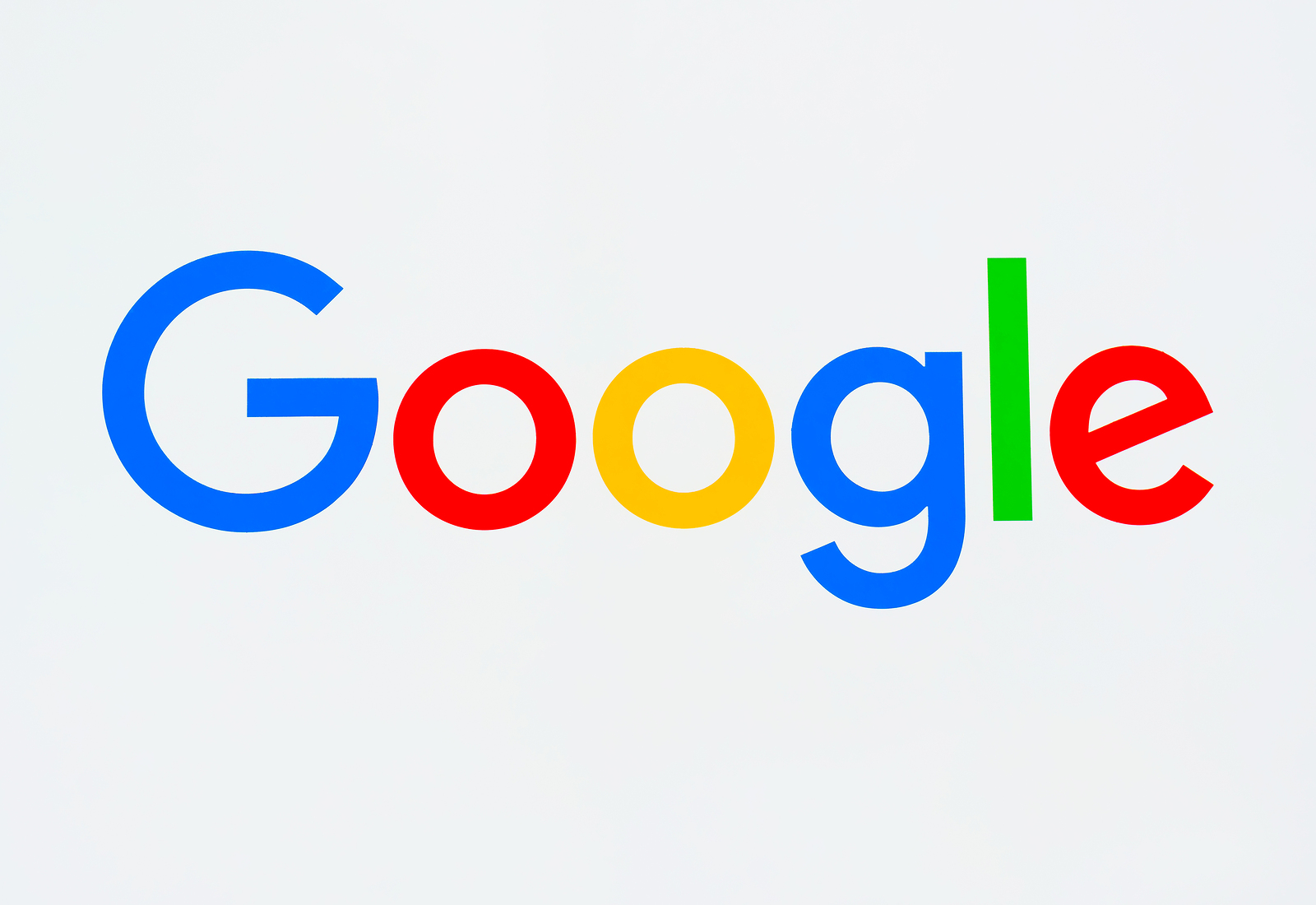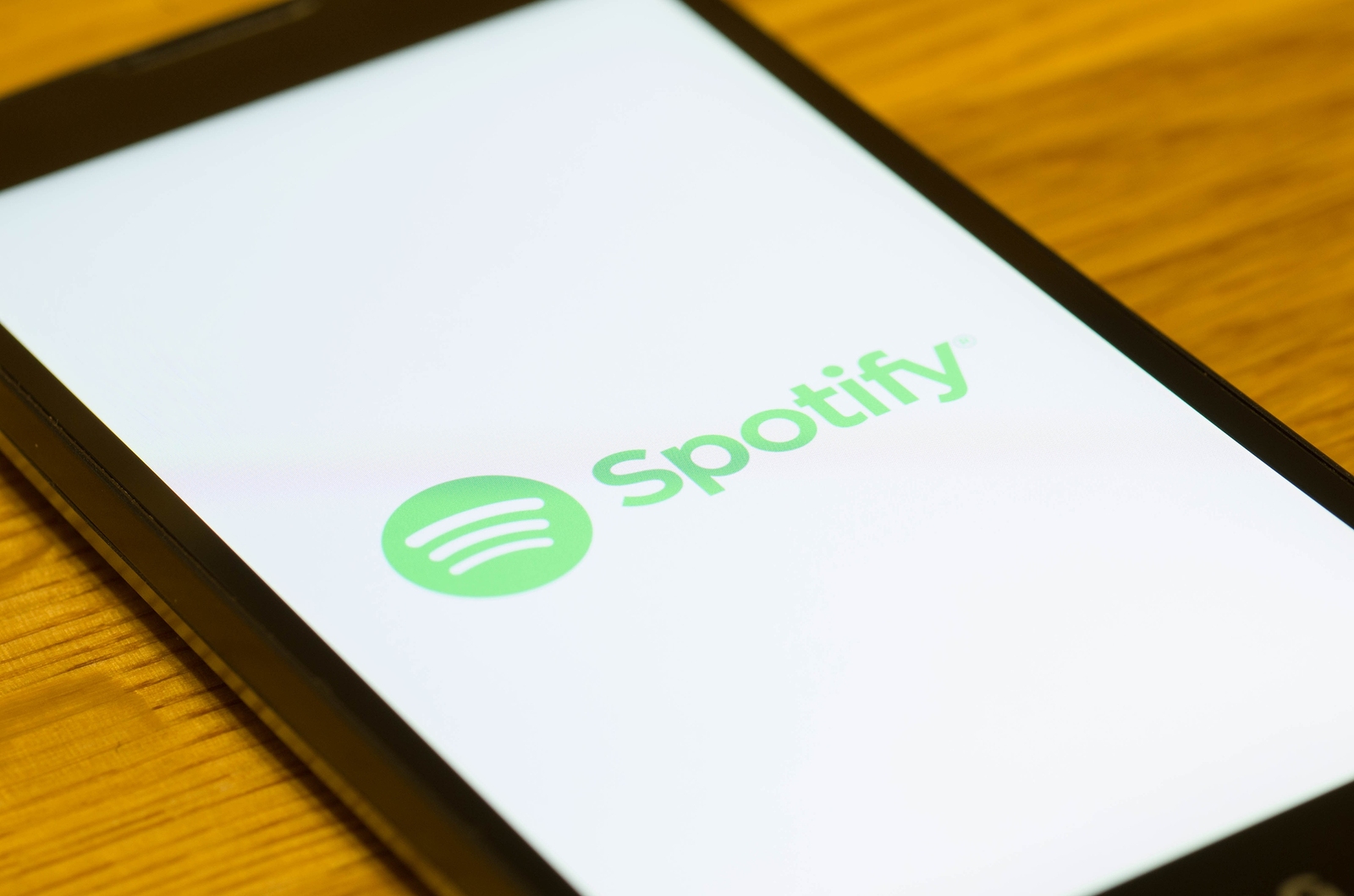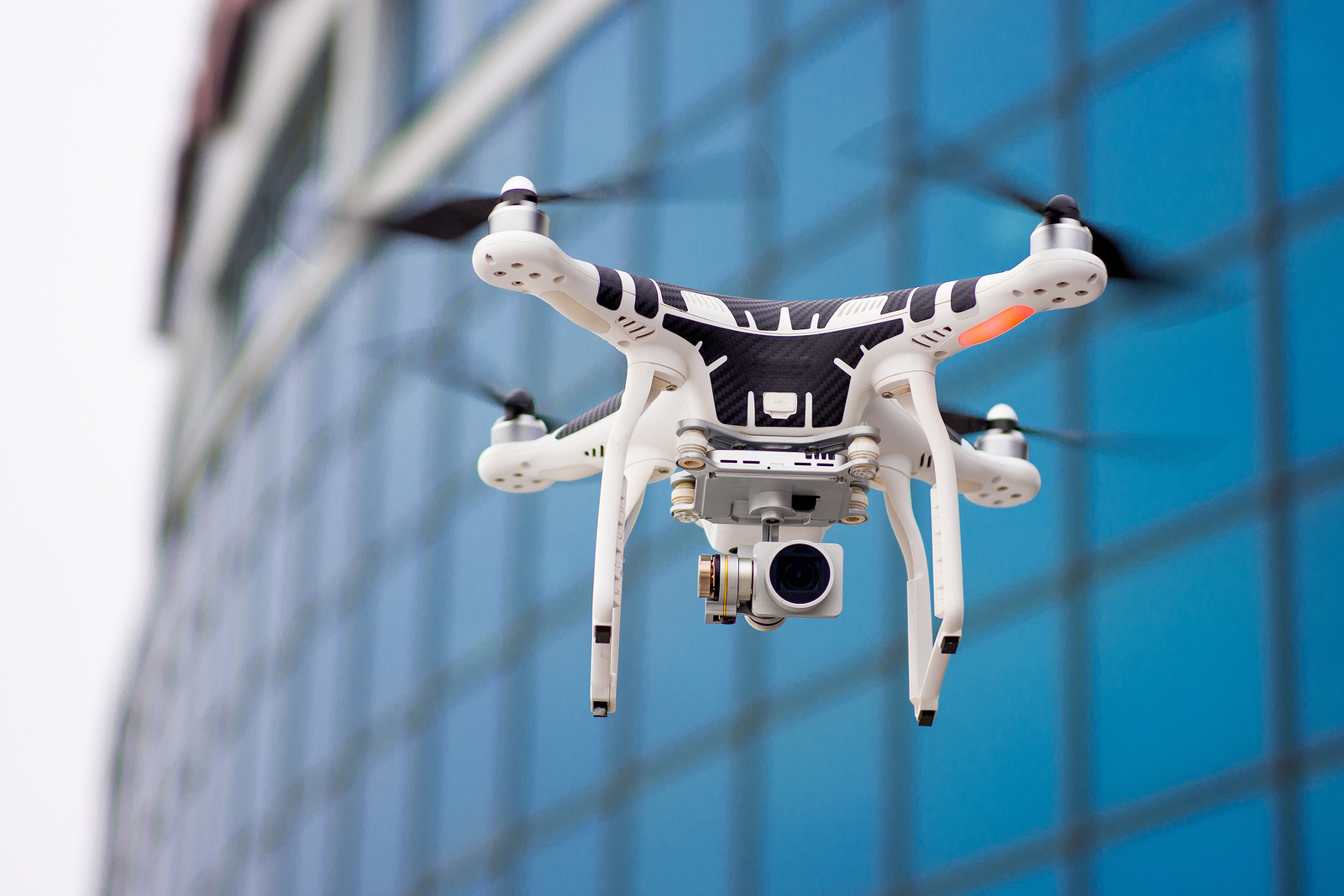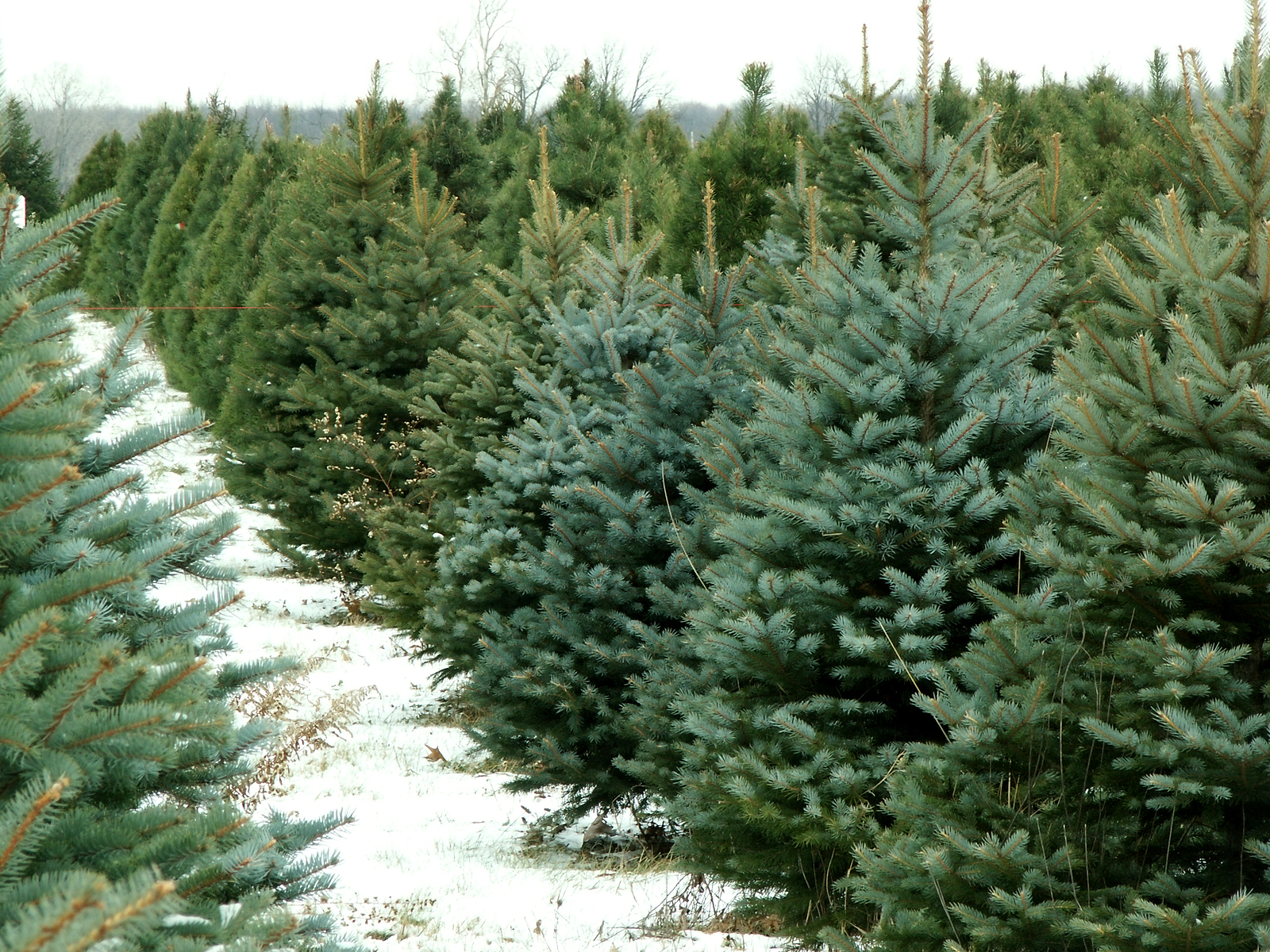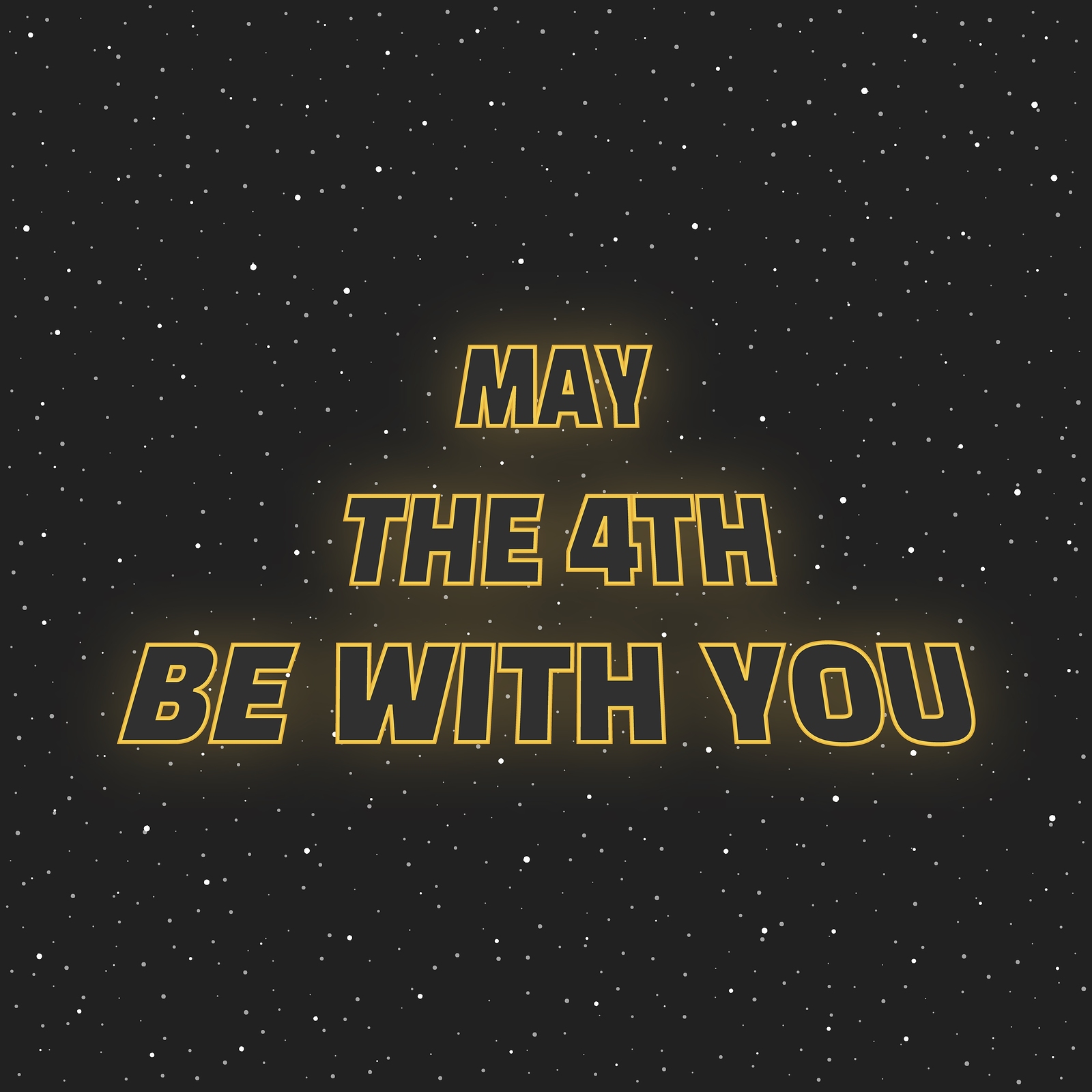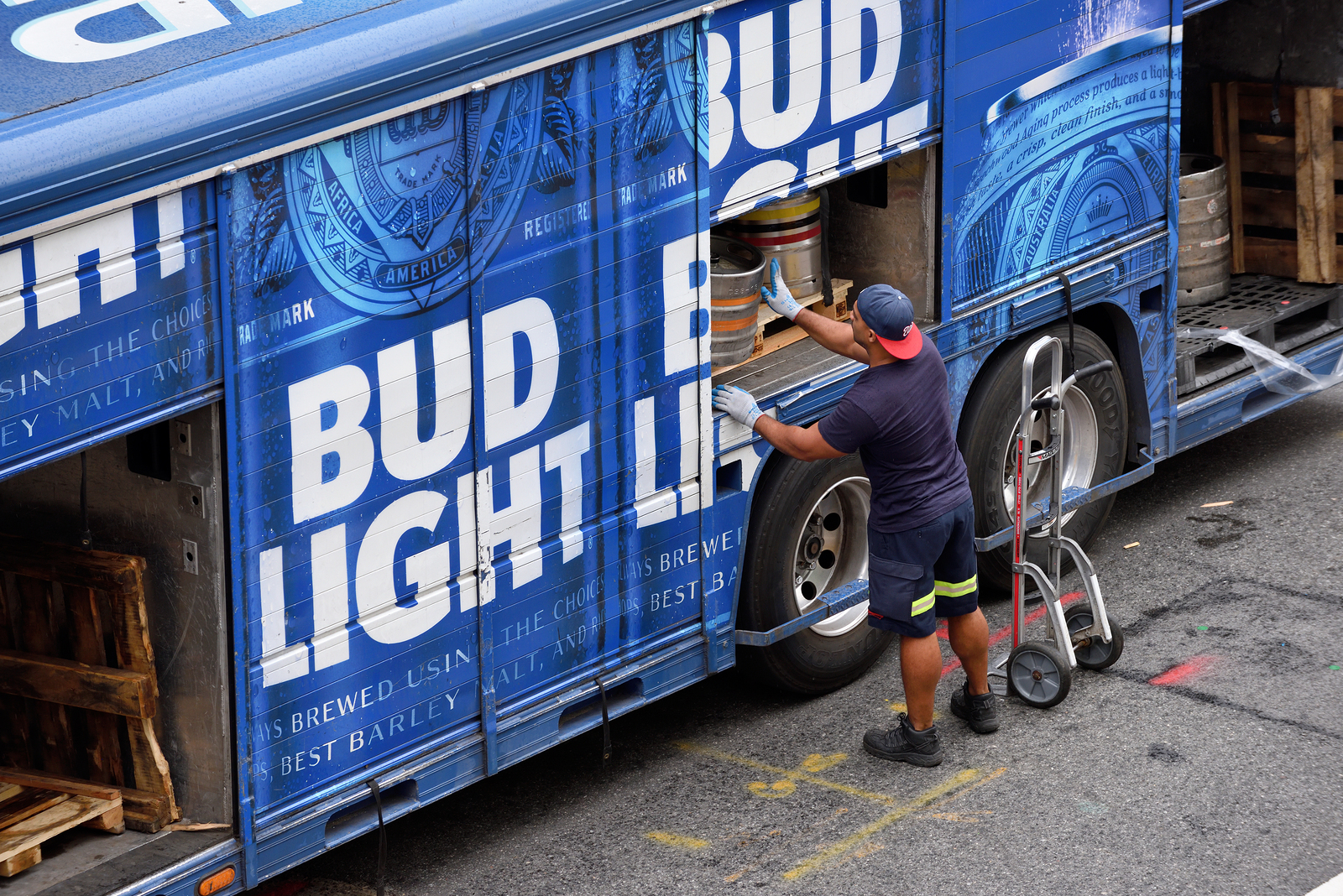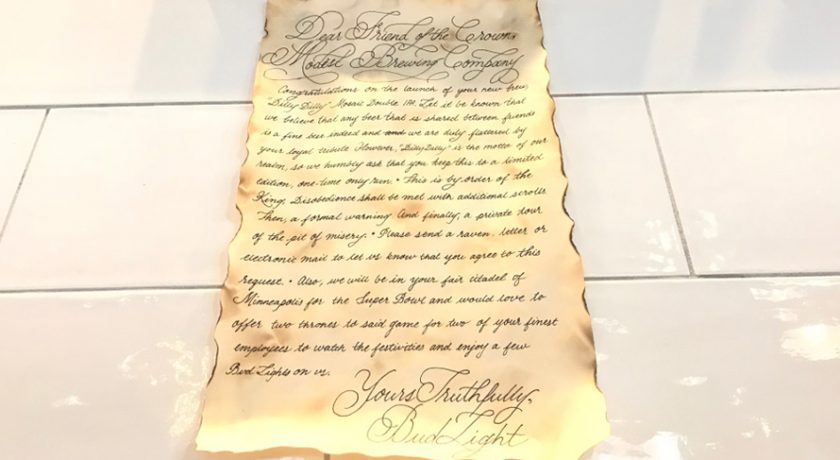Kaz Toyama to Serve on Panel for the Center for Sustainable Nanotechnology
Kaz Toyama, patent agent for Suiter Swantz IP, will serve on a panel for the Center for Sustainable Nanotechnology. Panelists will discuss Non-Traditional Chemistry Careers.
The webinar will be held Wednesday, January 31, 2:30-3:30 Central. Panelists will take about 7-8 minutes to talk about their job and career path, There will be a questions and answer section at the end as well.
Patent of the Week: Soda Fountain
Samuel Fahnestock was granted a patent for the first soda fountain on April 23, 1819. MINERAL WATER APPARATUS, U.S. Patent No. X3,096.
While soda fountains have given way to bottled and canned soda, they were once a fixture in towns and cities across the United States. Soda Fountains were introduced as early as 1758 when the term “soda water” was first used.
Naturally carbonated waters were well known throughout history for their unique healing properties. The water was commonly prescribed for stomach pain and indigestion since it had little to no side effects, unlike the medications used at that time. Originally most soda fountains were found inside drug stores as there were no laws governing the use of drugs and medication in beverages. Ingredients such as caffeine and cocaine were regularly added to the soda, along with other flavorings to make them taste better.
As the popularity of soda fountains rose so did the technology behind them. In 1819, Samuel Fahnestock was granted a patent for the first Soda Fountain (Mineral Water Apparatus). His invention pumped carbonated water from a pump and spigot. The barrel-shaped body of his device was designed so it could be concealed and hidden under a counter.

Suiter Swantz IP is a full-service intellectual property law firm, based in Omaha, NE, serving all of Nebraska, Iowa, and South Dakota. If you have any intellectual property questions or need assistance with any patent, trademark, or copyright matters and would like to speak with one of our patent attorneys please contact us.
Supreme Court Declined to Hear Case on Google’s Trademark as Generic
On Monday, October 16th, the Supreme Court of the United States denied certiorari of a petition that stated Google has become a generic verb which would make it ineligible for trademark protection.
We previously wrote about the case that originated when Chris Gillespie registered 763 domain names involving a person or a brand paired with the word “google,” for example, “googledisney.com” and “googlebarackobama.com.” Google objected to the registrations and filed a complaint arguing that Gillespie was cybersquatting; registering names, specifically well-known company/brand names, in hopes of selling them for a profit. Google was able to get the domain names transferred, but Gillespie and partner David Elliott filed a joint lawsuit against Google “for cancellation of the GOOGLE trademark under the Lanham Act, which allows cancellation of a registered trademark if it is primarily understood as a ‘generic name for the goods or services, or a portion thereof, for which it is registered.’” 15 U.S.C. § 1064(3).
The Ninth Circuit Court of Appeals ruled in favor of Google. According to court documents, Circuit Judge Richard Tallman wrote, “even if we assume that the public uses the verb ‘Google’ in a generic and indiscriminate sense, this tells us nothing about how the public primarily understands the word itself, irrespective of its grammatical function, with regard to internet search engines.”
When a trademark is used generically, a trademark owner may have to take aggressive measures to retain exclusive rights to the mark. Google has taken such steps by discouraging publications from using the term ‘googling’ in reference to web searches and they send cease and desist letters to those infringing on their trademark.
After the Supreme Court’s denial, Richard Wirtz, attorney for the plaintiff, stated in an email that he feels Congress should step in and start addressing the “trademark verbing.” He also stated, “[w]hile the Ninth Circuit landmark decision is now the single authority addressing the verbing of trademarks in the U.S., we don’t believe it is the end of the ‘verbing of trademark’ legal issue,” he wrote. “As the law stands right now, we don’t see how any owner of a trademark can intelligently police verb usage, which will most likely result in further challenges to verb-ed trademarks.”
The Supreme Court’s denial will be seen as a win for prominent brand owners who are at risk of becoming victims of their own success.
Suiter Swantz IP is a full-service intellectual property law firm, based in Omaha, NE, serving all of Nebraska, Iowa, and South Dakota. If you have any intellectual property questions or need assistance with any patent, trademark, or copyright matters and would like to speak with one of our patent attorneys please contact us.
Spotify Sued for $1.6 billion over Copyright Infringement
California-based Wixen Music Publishing has sued the streaming music provider, Spotify for $1.6 billion. The lawsuit was filed in the US District Court for the Central District of California, Western Division on December 29, 2017.
Wixen is an independent music publisher who administers more than 50,000 songs written and/or owned by its more than 2,000 clients. The publishing company is seeking injunctive relief and damages in the amount of $150,000 for each song listed; the list is comprised of more than 10,000 songs.
Wixen alleged the streaming service is using tens of thousands of songs without license. Some of those songs include artists that Wixen is the exclusive licensee for, the artists include Tom Petty, Santana, Journey, The Beach Boys, The Doors, Janice Joplin, and Stevie Nicks to name a few.
Wixen stated "Spotify brazenly disregards United States Copyright law and has committed willful, ongoing copyright infringement.” Wixen further claimed that “Spotify has built a [billion-dollar] business on the backs of songwriters and publishers whose music [they are] using, in many cases without obtaining and paying for the necessary licenses.”
Wixen filed the lawsuit shortly after the Music Modernization Act was introduced in December 2017. This bill became effective January 1, 2018, and it will enable “digital music companies to find the owners of the music they use and [reform] the rate setting process for performing rights, ensuring that songwriters and music publishers are paid faster and more fairly than ever before.”
In light of this new bill, Randall Wixen, President of Wixen Music Publishing, stated “[n]either we nor our clients are interested in becoming litigants but we have been faced with a choice of forfeiting rights and damages, or taking action at this time. We regret that this otherwise admirable proposed bill has had this effect, and we hope that Spotify nonetheless comes to the table with a fair and reasonable approach to reaching a resolution with us. We are fully prepared to go as far forward in the courts as required to protect our clients’ rights.”
Although Spotify does pay royalties to artists and holders of the rights to songs, this is not the first time the service has been accused of infringement or criticized for their practices. Taylor Swift has been one of the most vocal artists to speak up about the practices of Spotify. She believed artists were being unfairly compensated for their works and at one point refused to have her songs released to the streaming site stating, “[m]usic is art, and art is important and rare. Important, rare things are valuable. Valuable things should be paid for. It’s my opinion that music should not be free.”
In the lawsuit, Wixen alleged that Spotify failed to compensate “songwriters royalties to a publishing company 21% of the time,” which is an estimated 6,300,000 compositions.
In May of 2017, songwriters David Lowery and Melissa Ferrick sued Spotify in a class action lawsuit for failing to pay them royalties for their work. Spotify offered to settle the case and paid the songwriters $43 million.
The Sweden-based Spotify was launched in the US in 2011, and currently has more than 140 million active followers and 60 million subscribers. The company has over 30 million songs in its catalog and is planning a stock market listing this year as the company’s value has risen to $19 billion in the past few months.
Suiter Swantz IP is a full-service intellectual property law firm, based in Omaha, NE, serving all of Nebraska, Iowa, and South Dakota. If you have any intellectual property questions or need assistance with any patent, trademark, or copyright matters and would like to speak with one of our patent attorneys please contact us.
Apple Applies for Patent on Self-Driving Car
While Uber and Waymo have been in the news for their self-driving cars and the patented technology behind them, Apple has been secretly working on their “Autonomous Navigation System.” Apple CEO Tim Cook referred to this project as the “mother of all projects.”
The iCar project, codenamed ‘Titan,’ began work in 2015. The corresponding patent application published on December 21, 2017. Cook commented that Apple is “focusing on autonomous systems. It’s a core technology that we view as very important.”
A lot of the self-driving technologies currently being tested rely on information systems that are unyielding, such as maps and sensors that use real-time updates on items that can change daily like road construction or the weather. This technology was intended to use less computing power; unfortunately, that may not be the case. Maps, weather condition sensors, and other features can become unsafe and obsolete because the necessary updates would require “dispatching a sensor suite to re-traverse the route, which can require an expenditure of time.”
Apple feels there is better way to solve the problem. The Apple patent application suggests their new navigation system will direct a vehicle “independently of any data received from any devices external to the vehicle, and any navigation data stored locally to the vehicle prior to any monitoring of navigation.” The proposed technology would utilize a computerized model for predicting routes using sensors and processors in the vehicle.
One feature of Apple’s self-driving car technology that others do not have is the ability to provide the driver with the option to manually drive the car or utilize the automated function. It would also provide the user the option to choose an alternate route if available.
The National Highway Traffic and Safety Administration granted Apple a permit for testing autonomous vehicles on public roads in California. The permit allows for three vehicles with up to six passengers who can take over driving if necessary. Apple has not commented on if or when the self-driving cars will be released.
Suiter Swantz IP is a full-service intellectual property law firm, based in Omaha, NE, serving all of Nebraska, Iowa, and South Dakota. If you have any intellectual property questions or need assistance with any patent, trademark, or copyright matters and would like to speak with one of our patent attorneys please contact us.
Patent of the Week: Multi-Functional Hand-Held Device (iPhone)
January 9, 2007, Steve Jobs, the late founder and CEO of Apple Inc., unveiled the iPhone (Multi-Functional Hand-Held Device US 2006/0197753) at the Macworld convention in San Francisco. Jobs said this phone would be a “revolutionary and magical product that is literally five years ahead of any other mobile phone.”
The patent application was filed on March 3, 2006, and was published September 7, 2006. The phone was released on June 29, 2007, and drew huge crowds; some camped out for days before the release while others waited in line for hours, all vying to be one of the first to get the phone. Less than a year after Jobs announced this new technology 14.1 million iPhones had been sold. Time magazine named it their “invention of the year.”
The release of the iPhone played a pivotal role in turning Apple Inc. into one of the most valuable corporations in the world.
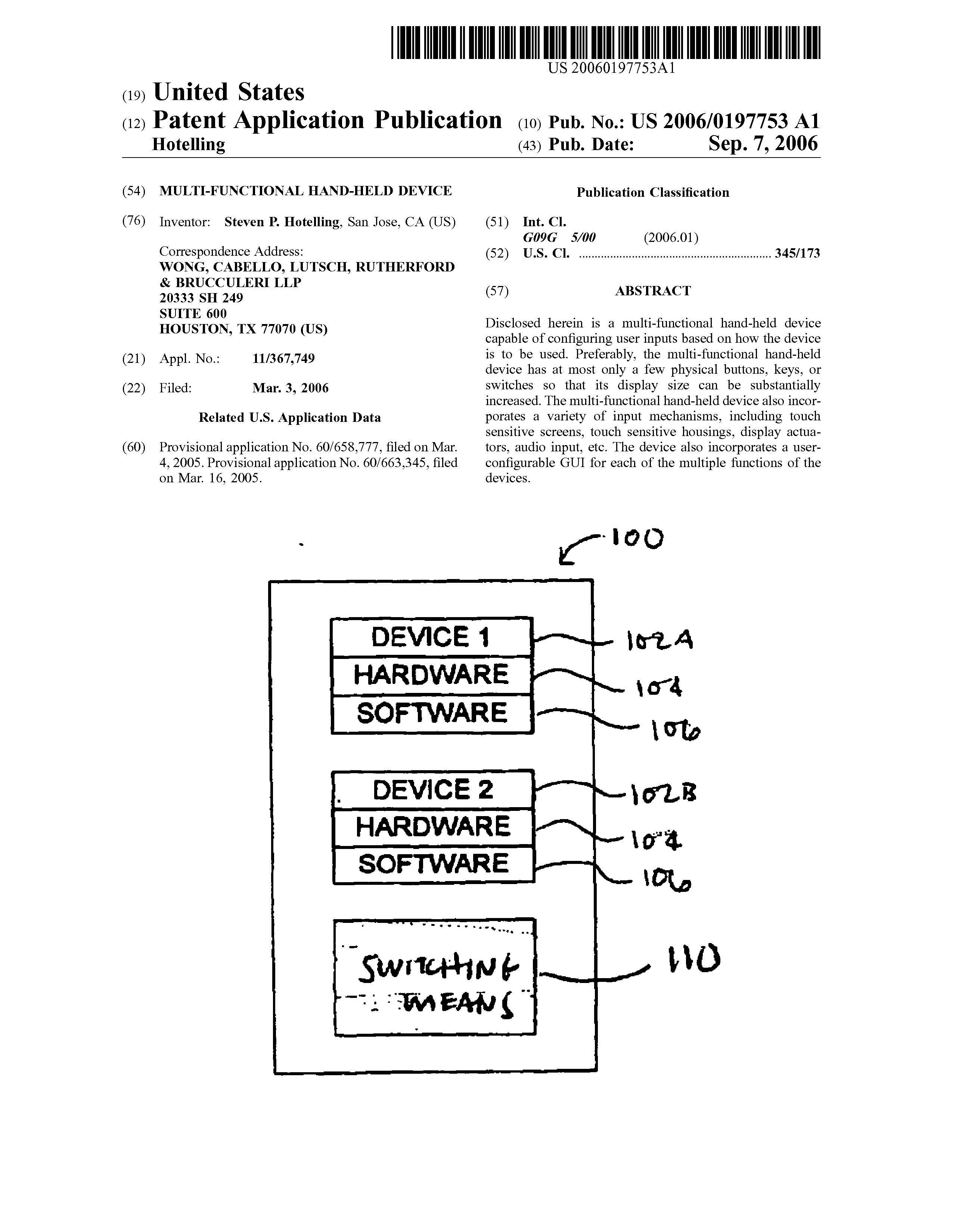
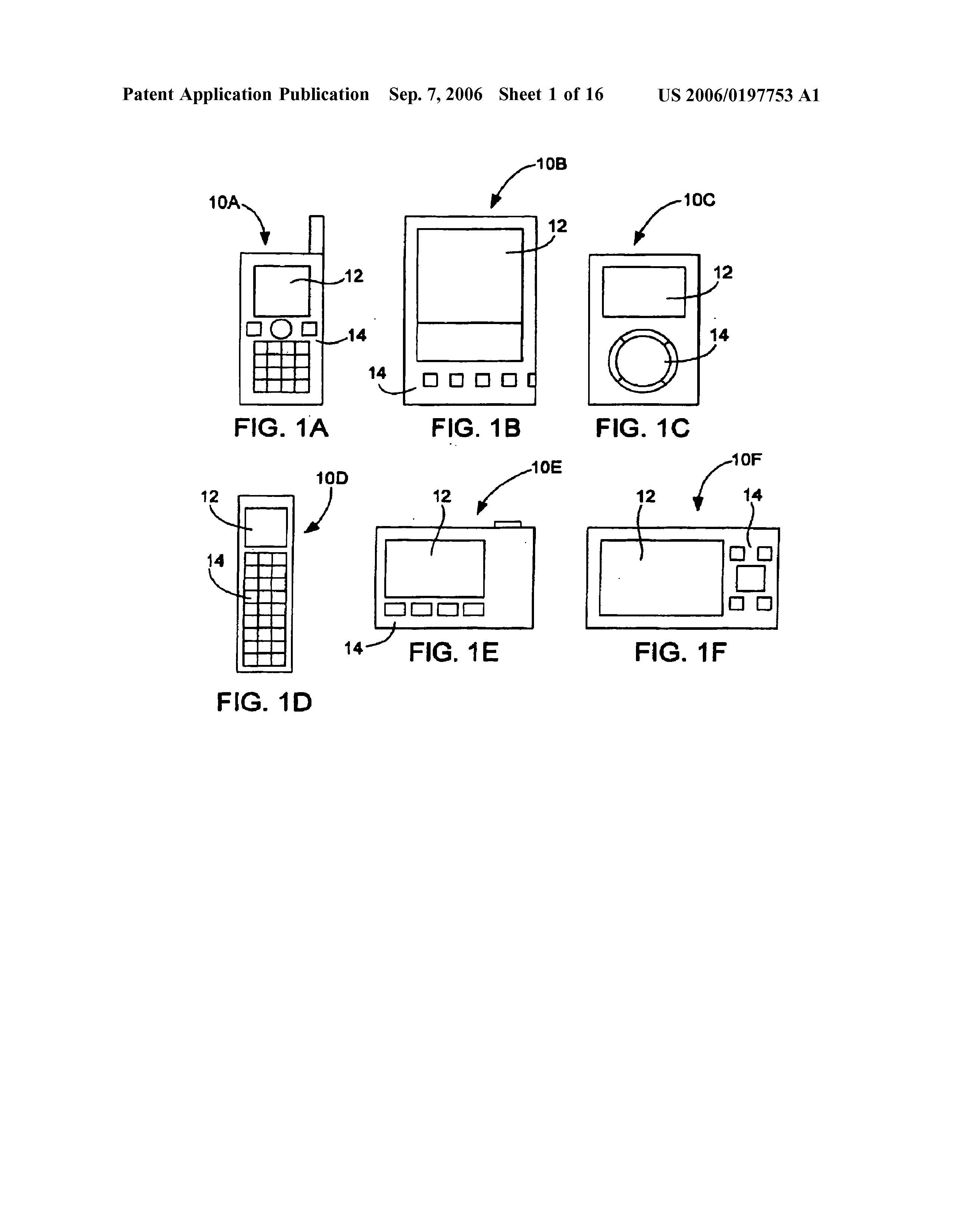
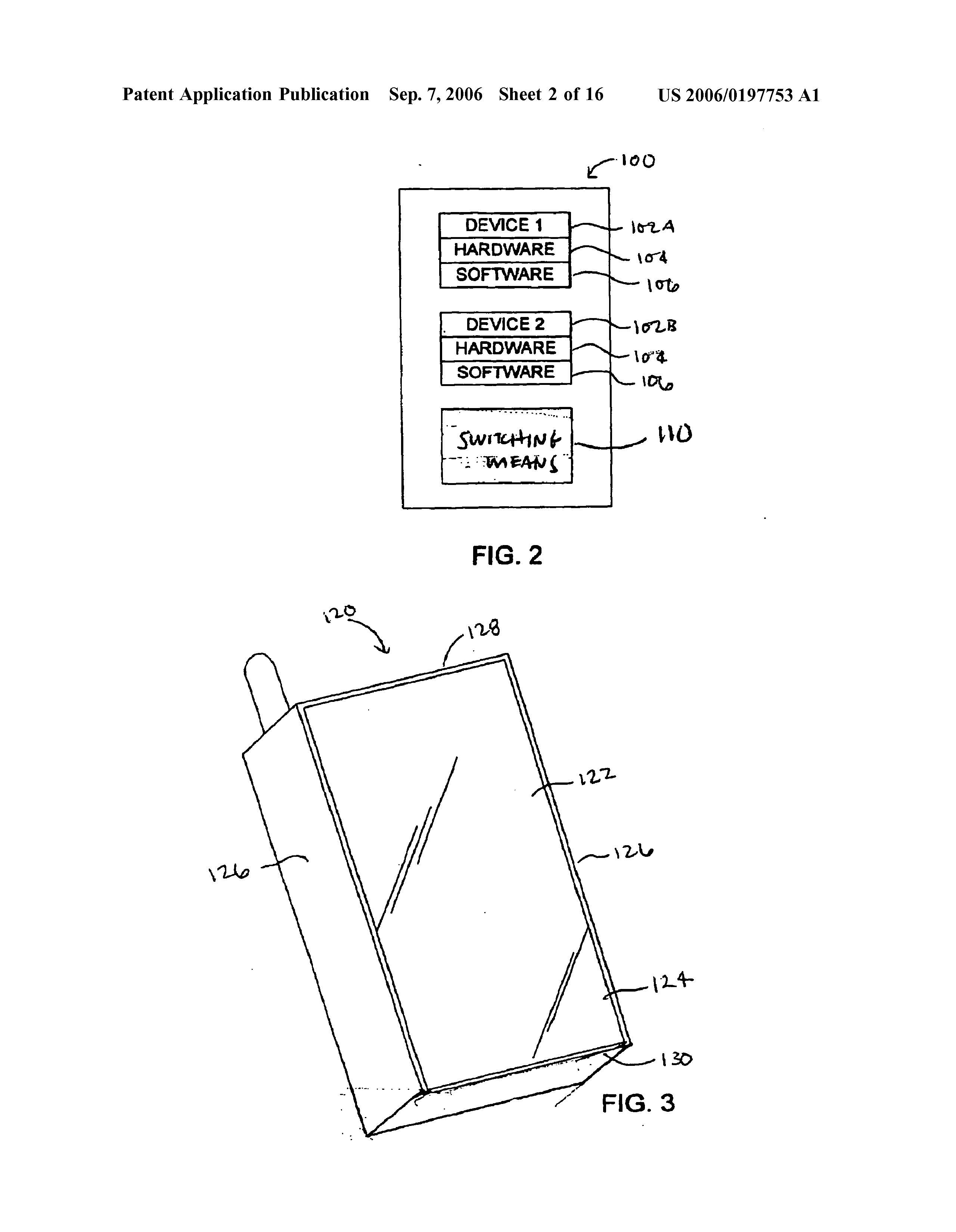
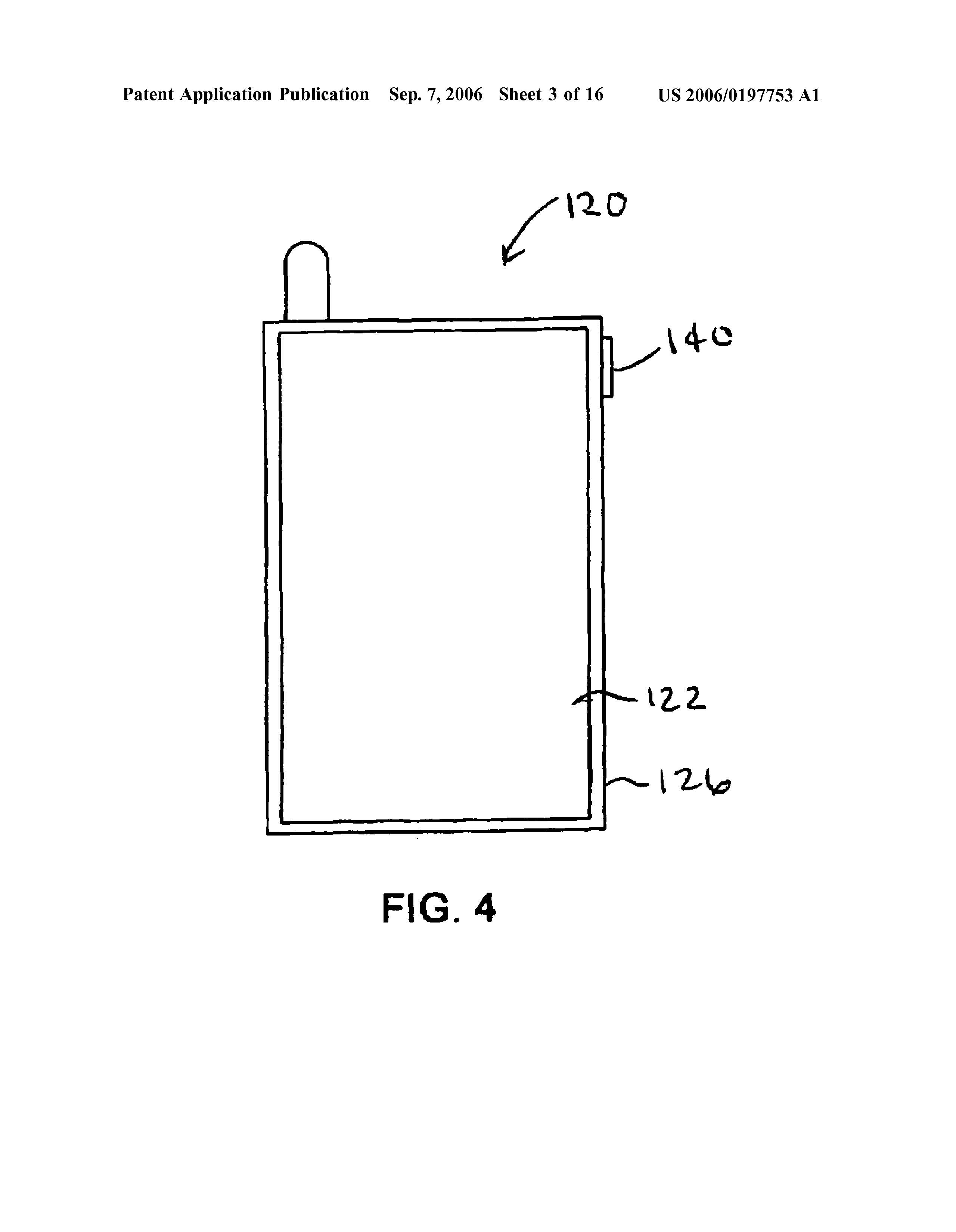
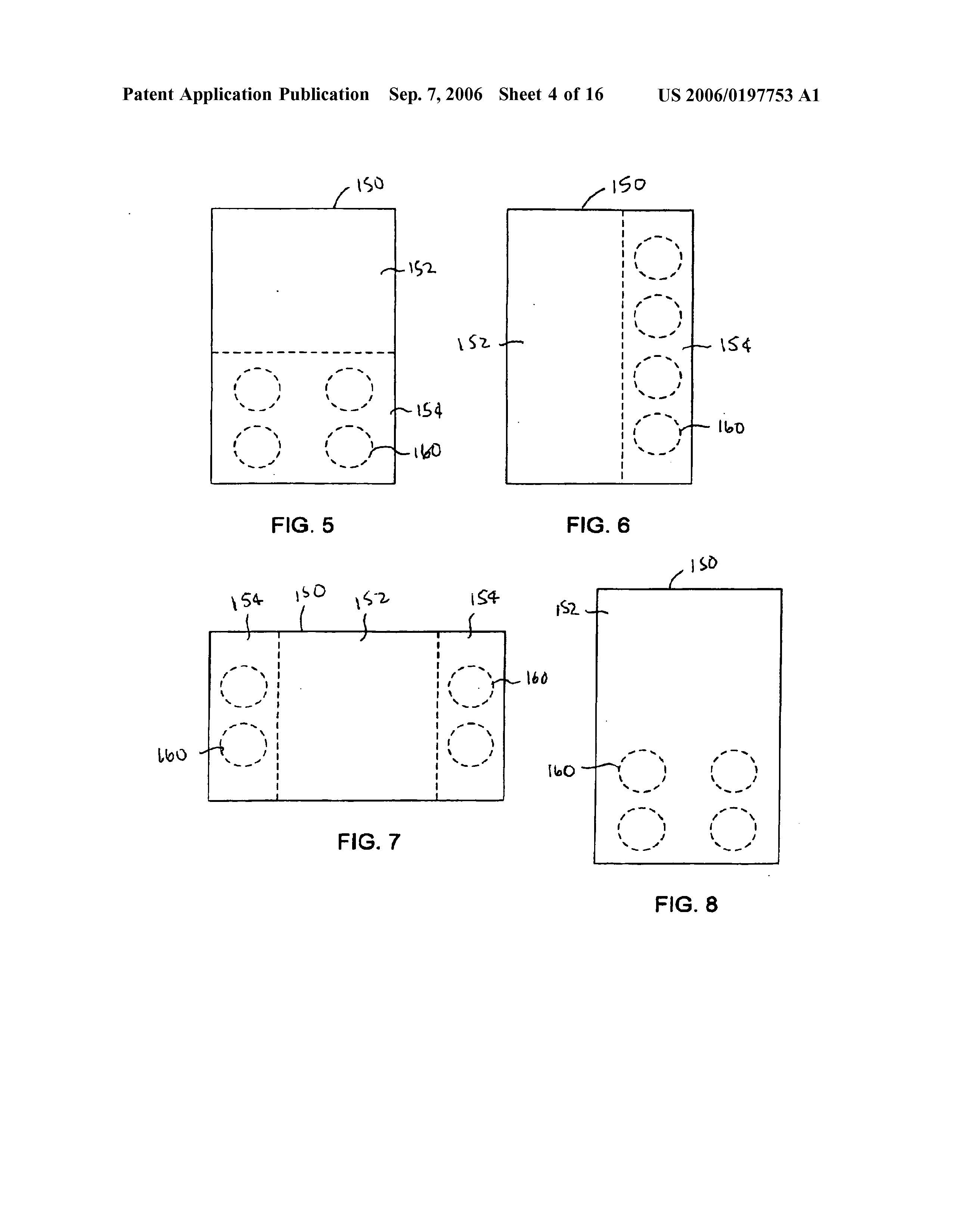
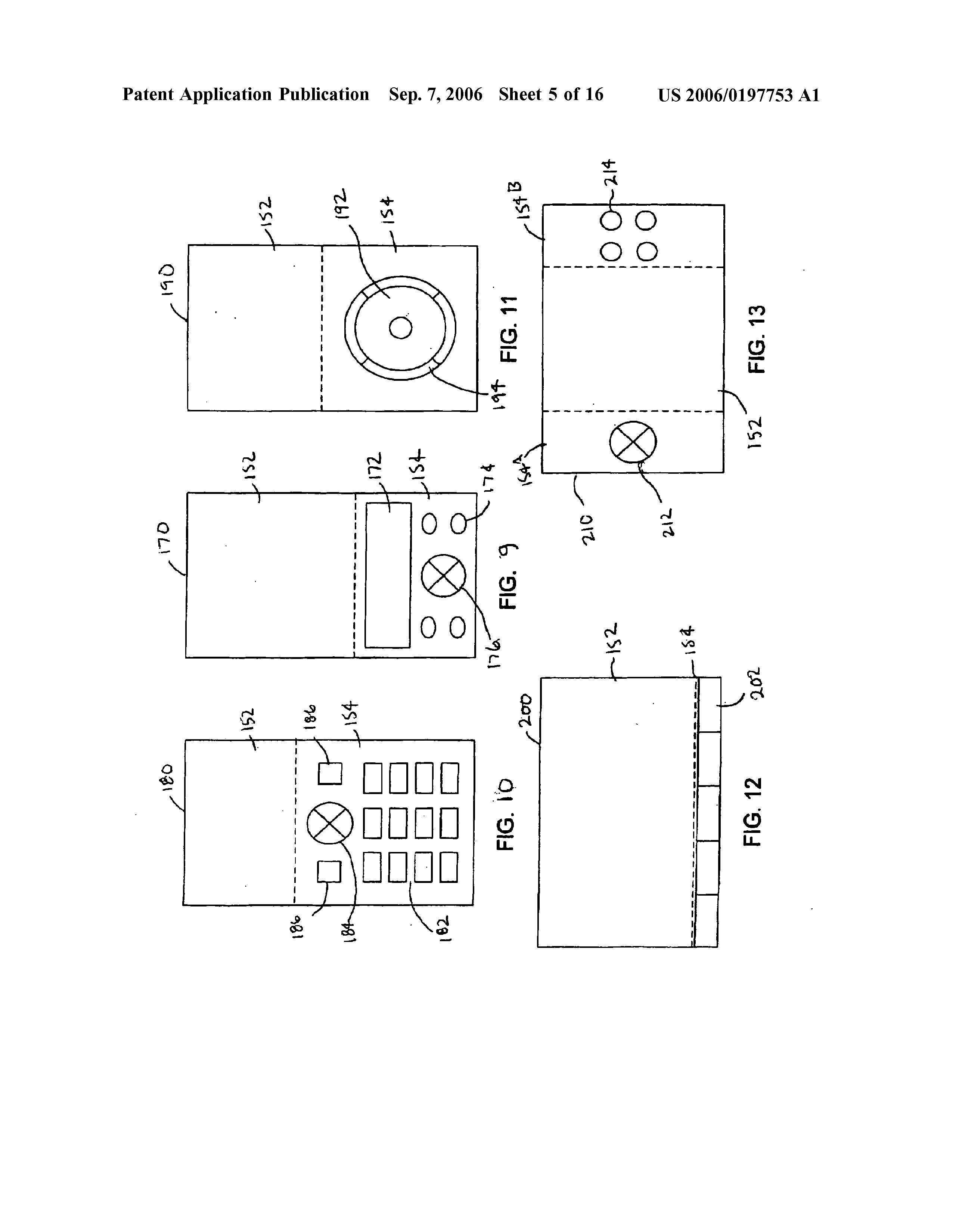
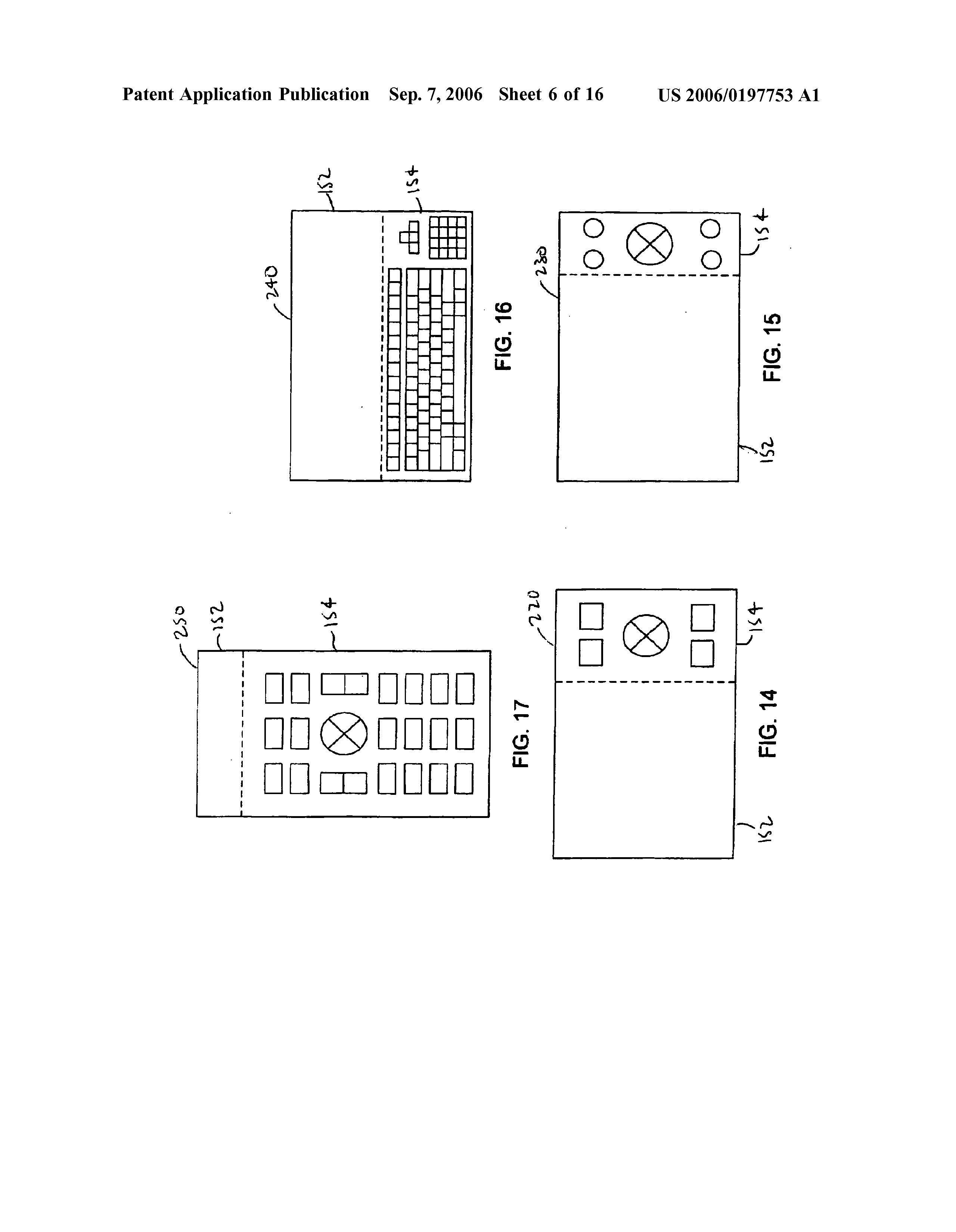
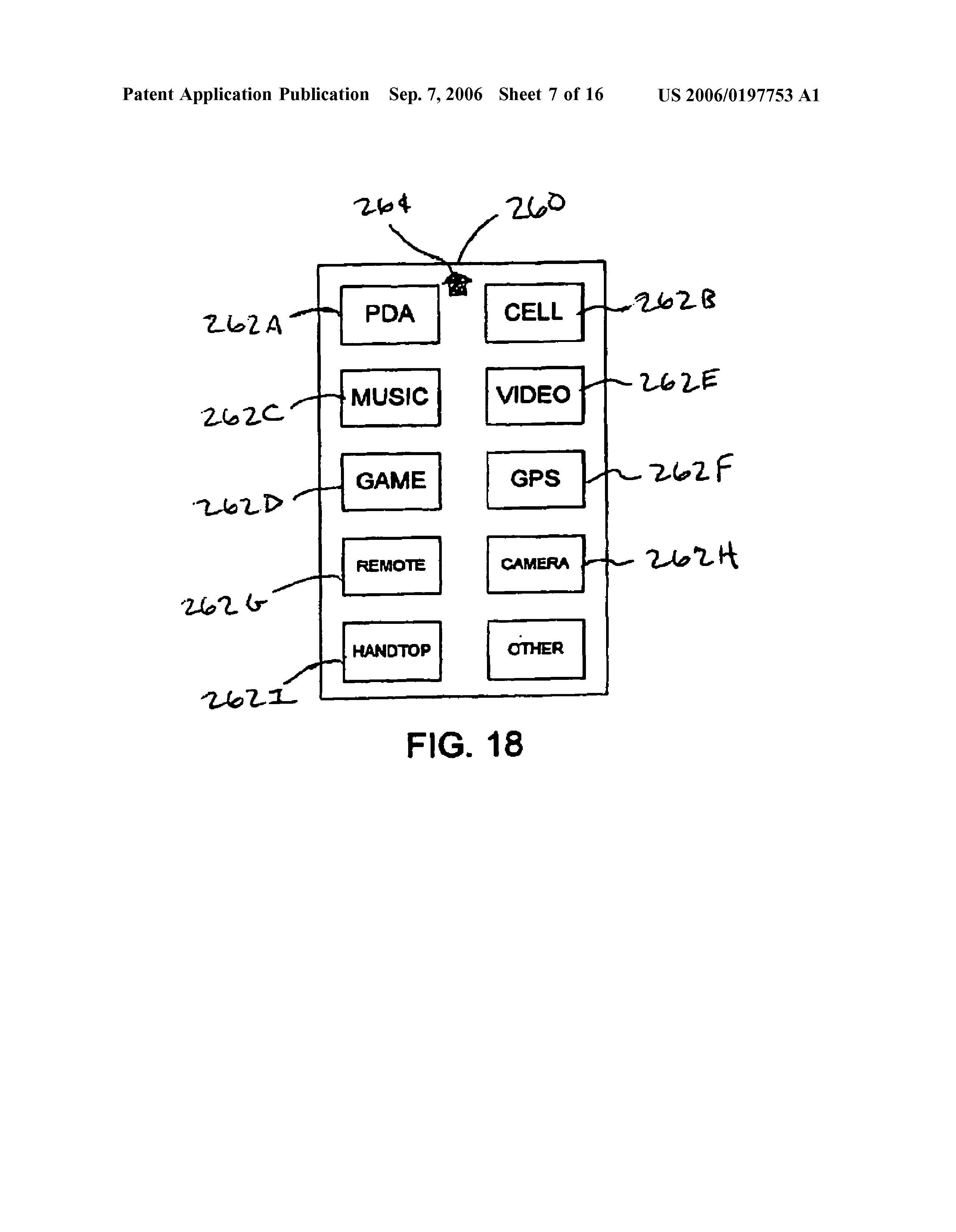
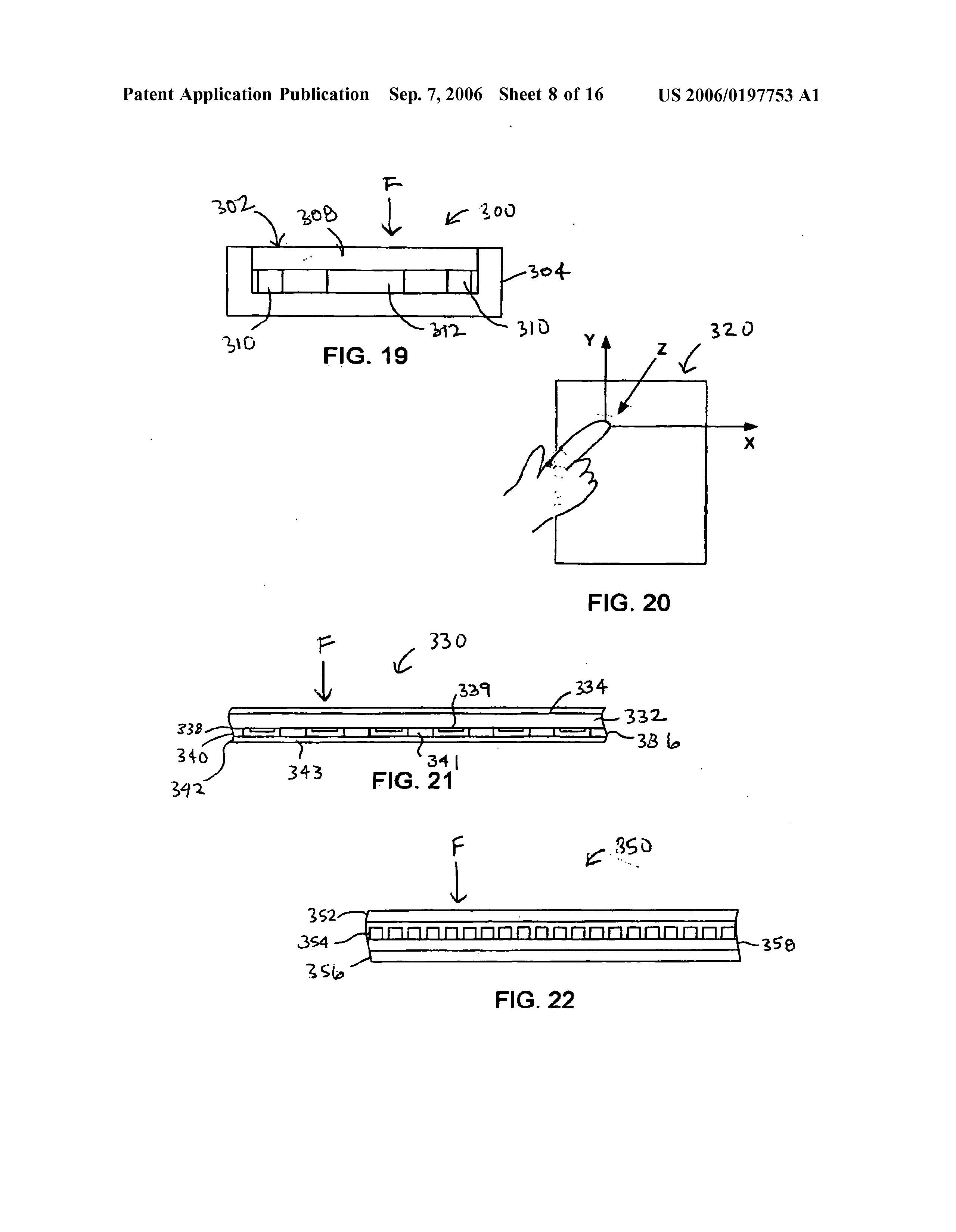
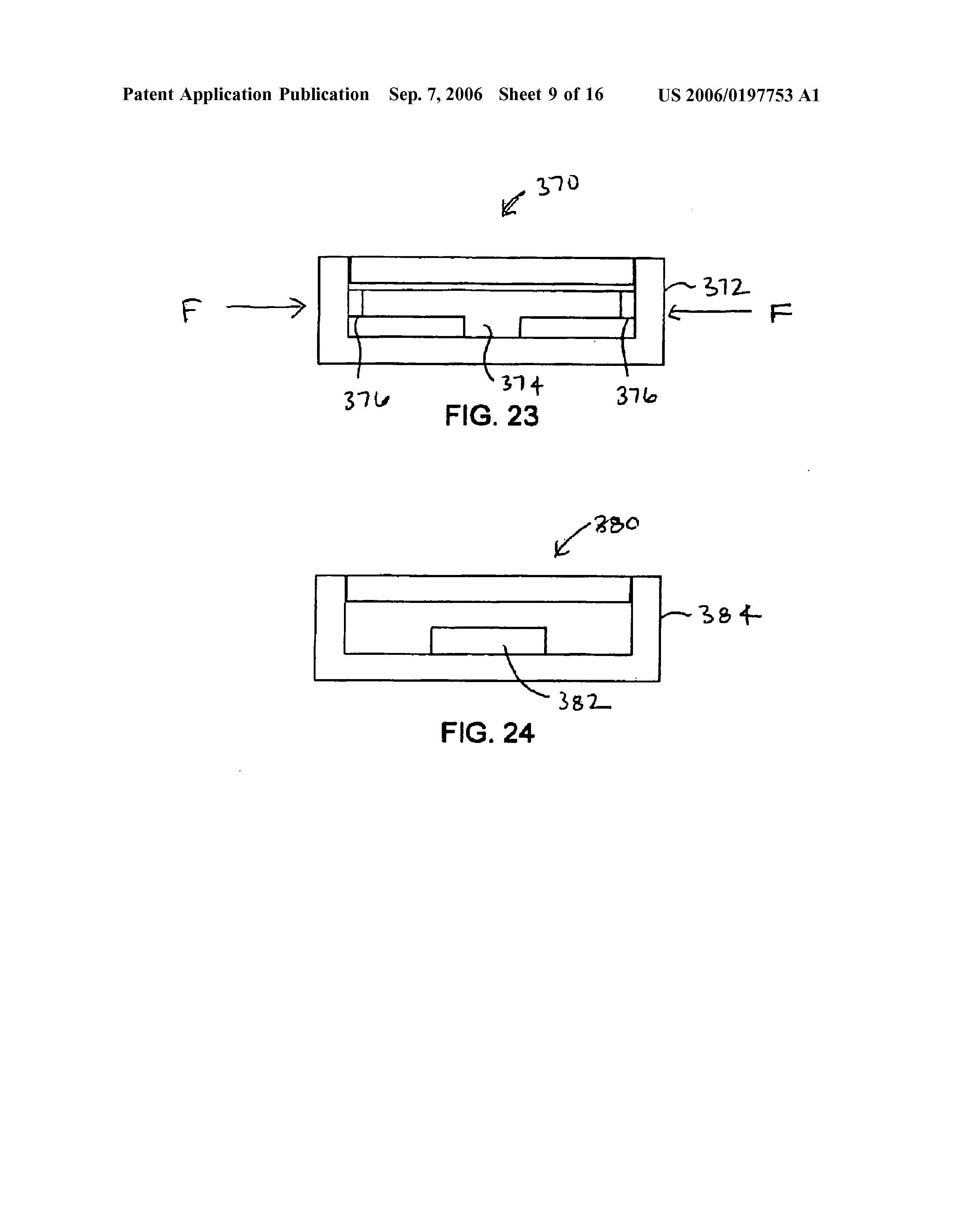
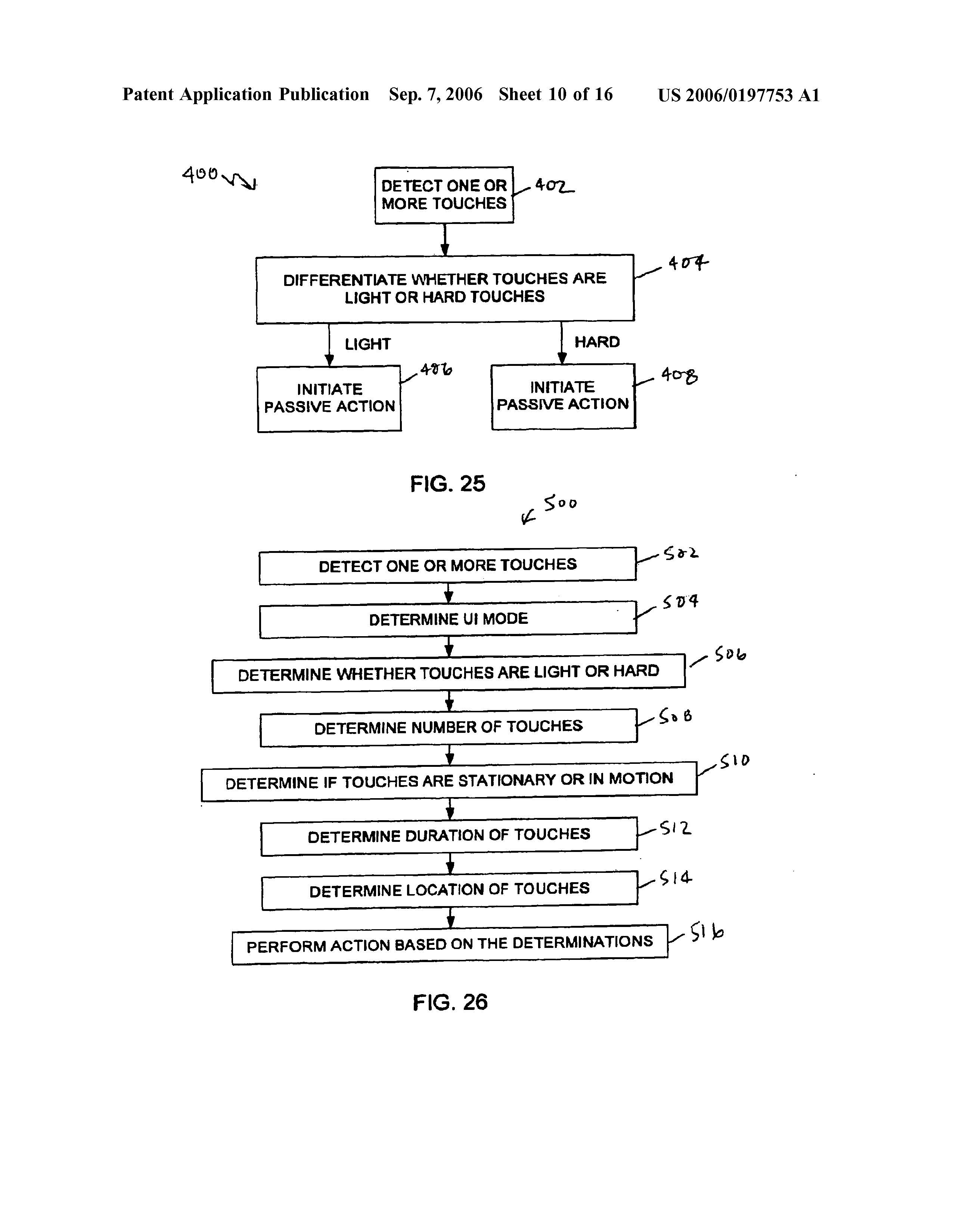
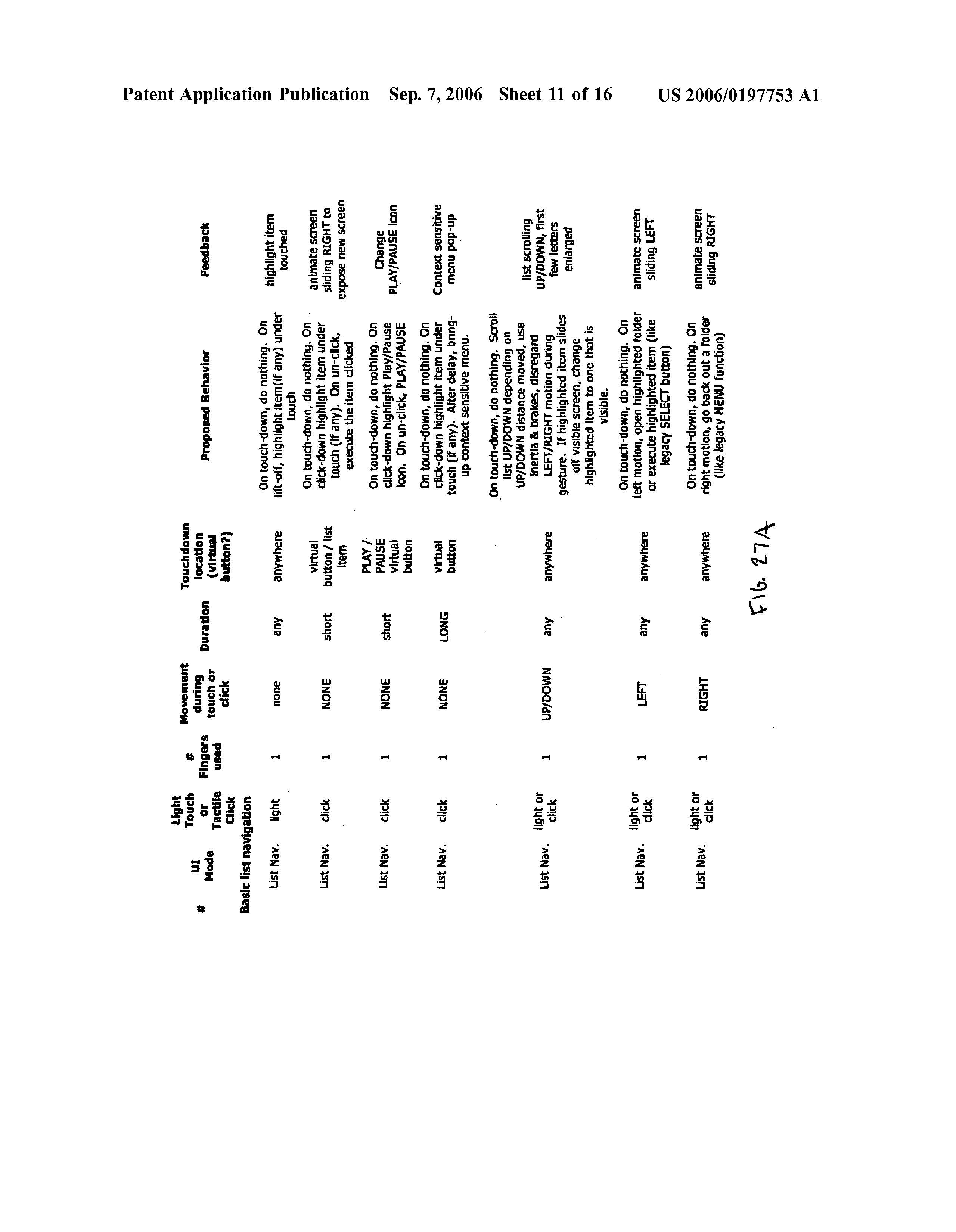
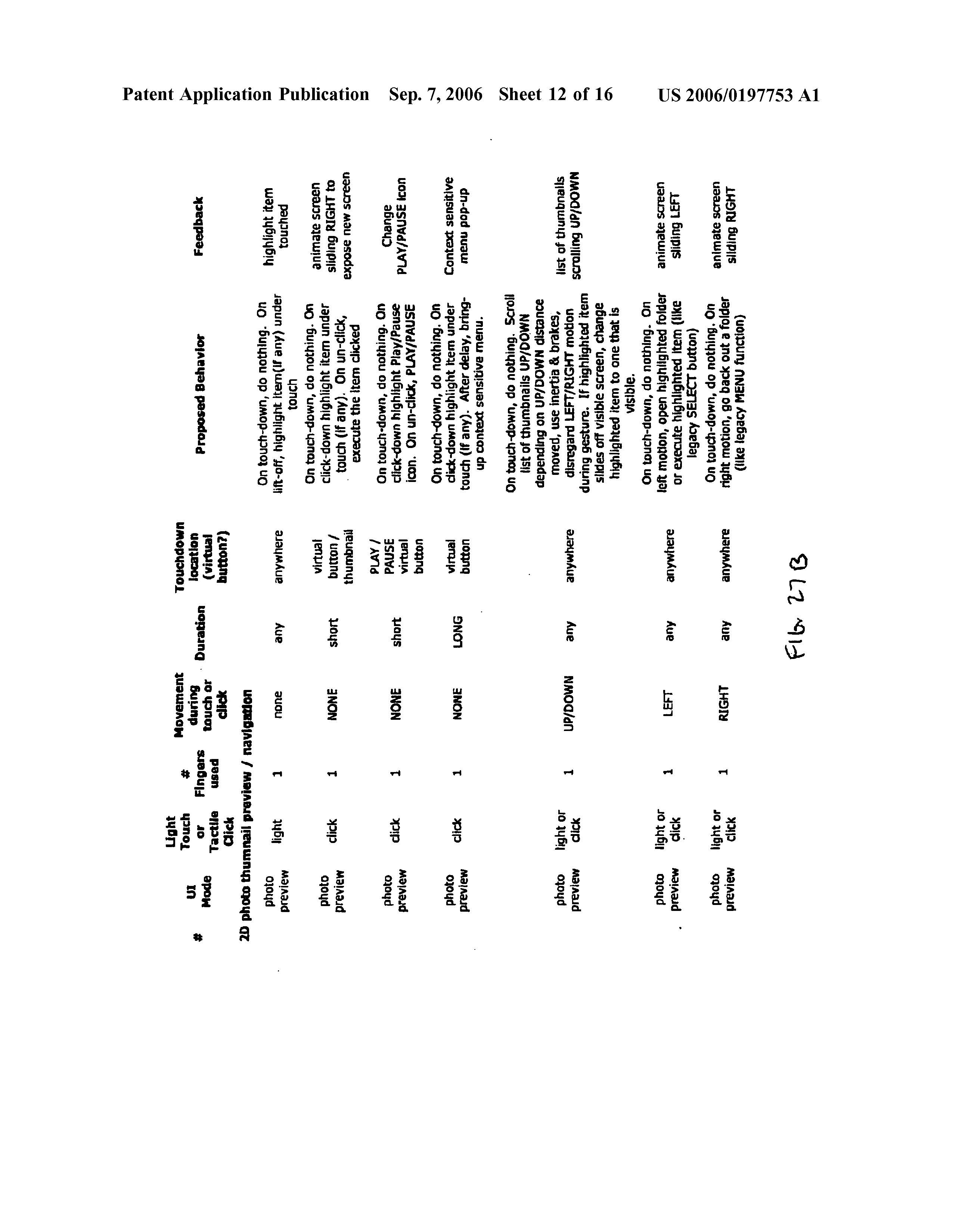
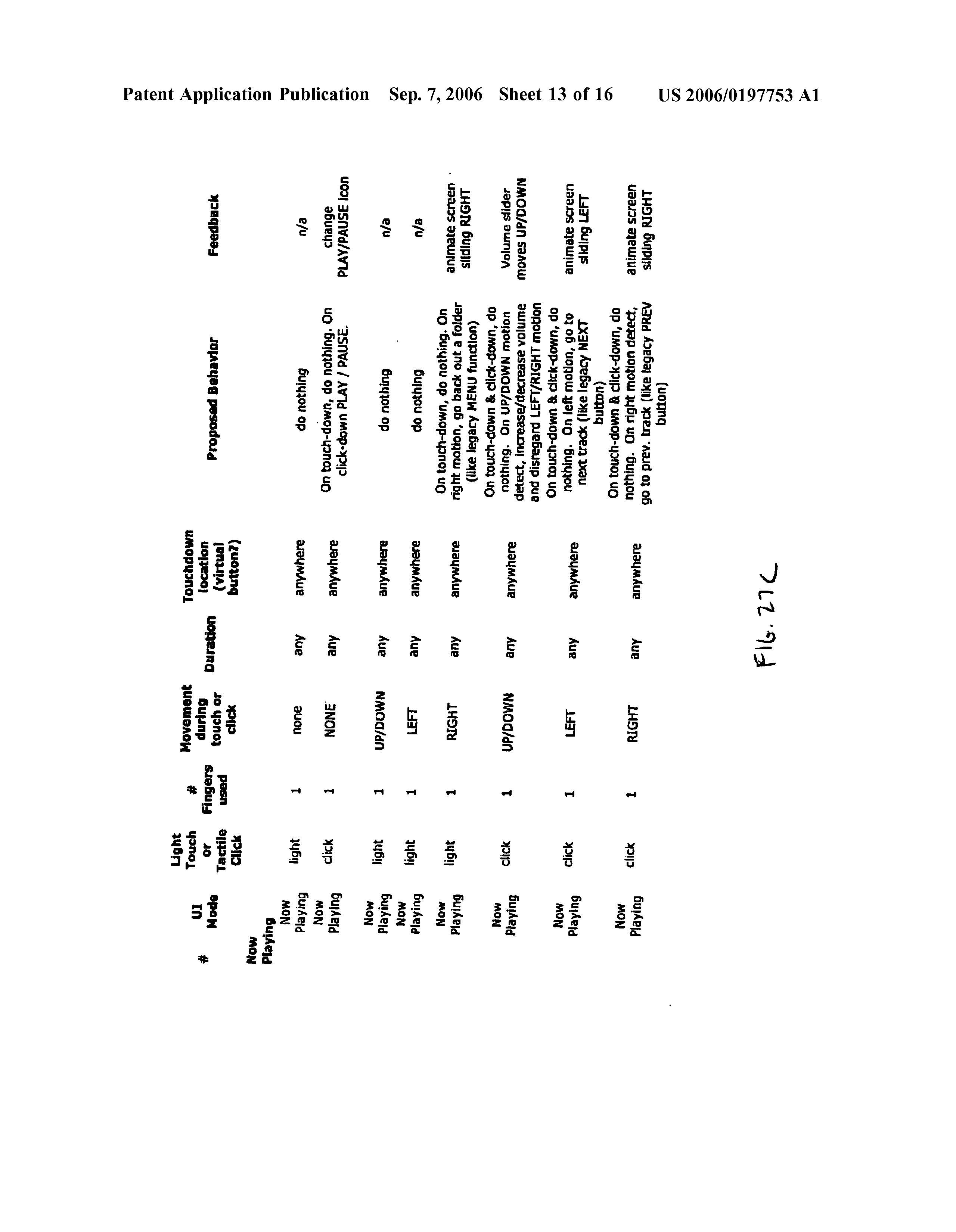
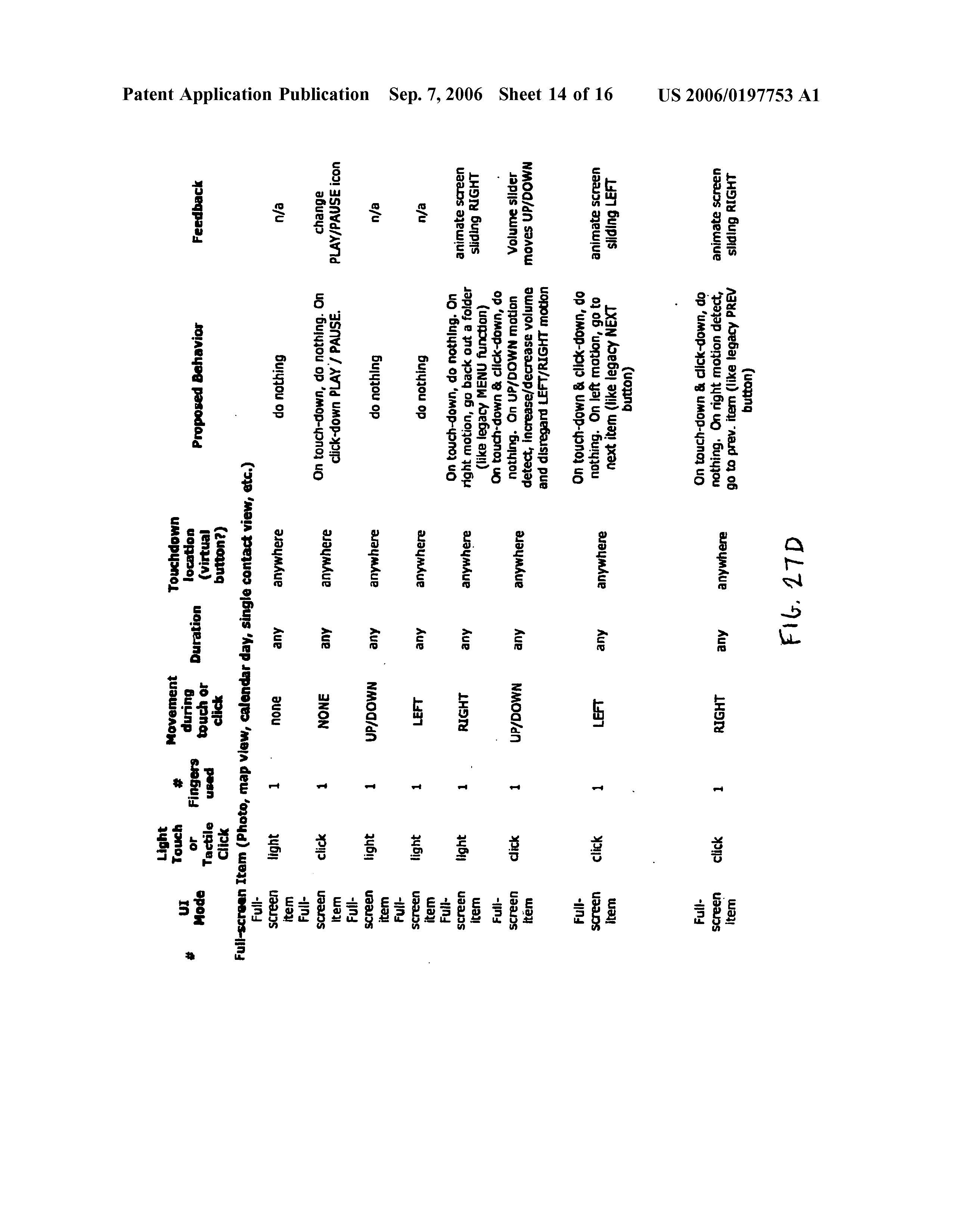
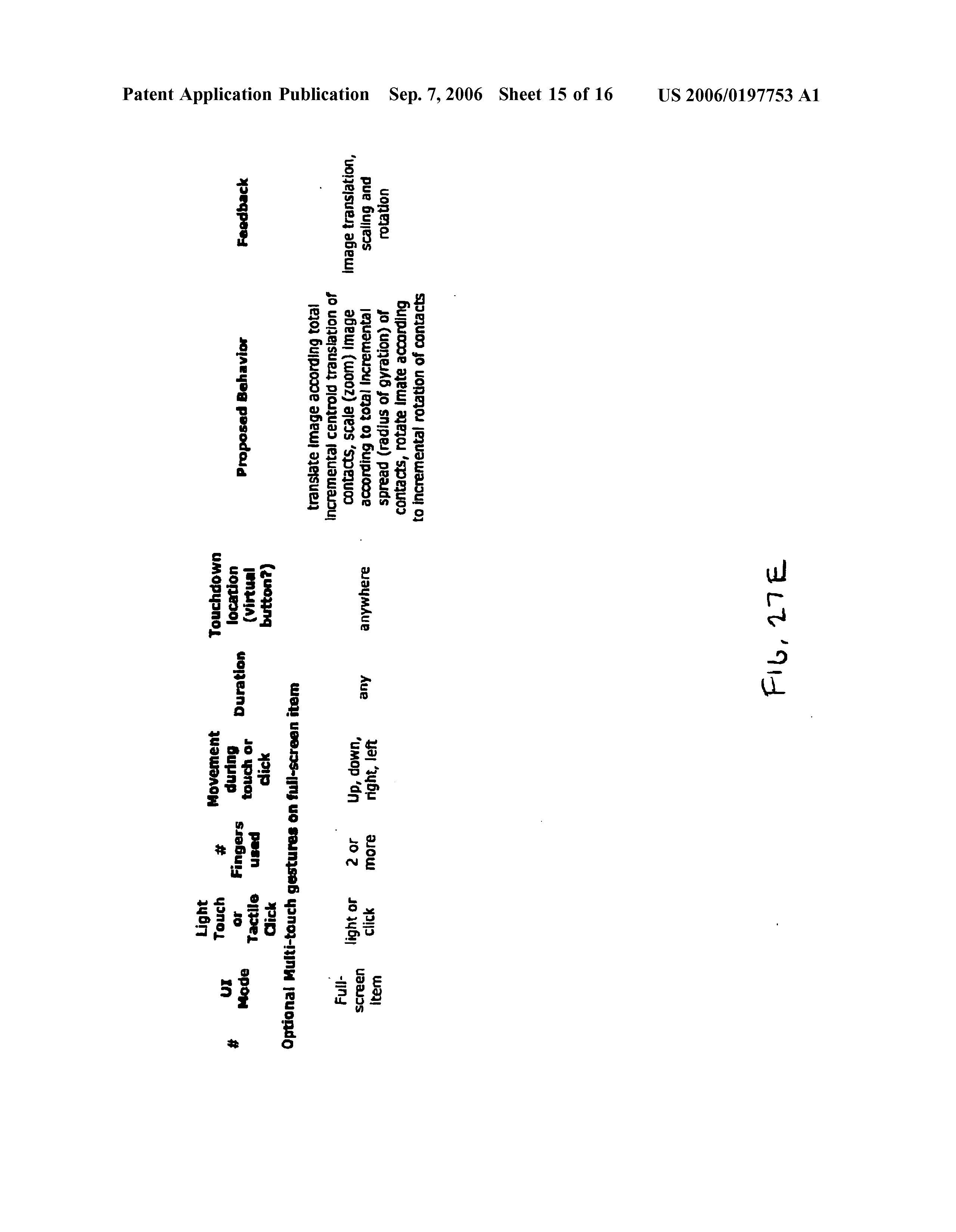
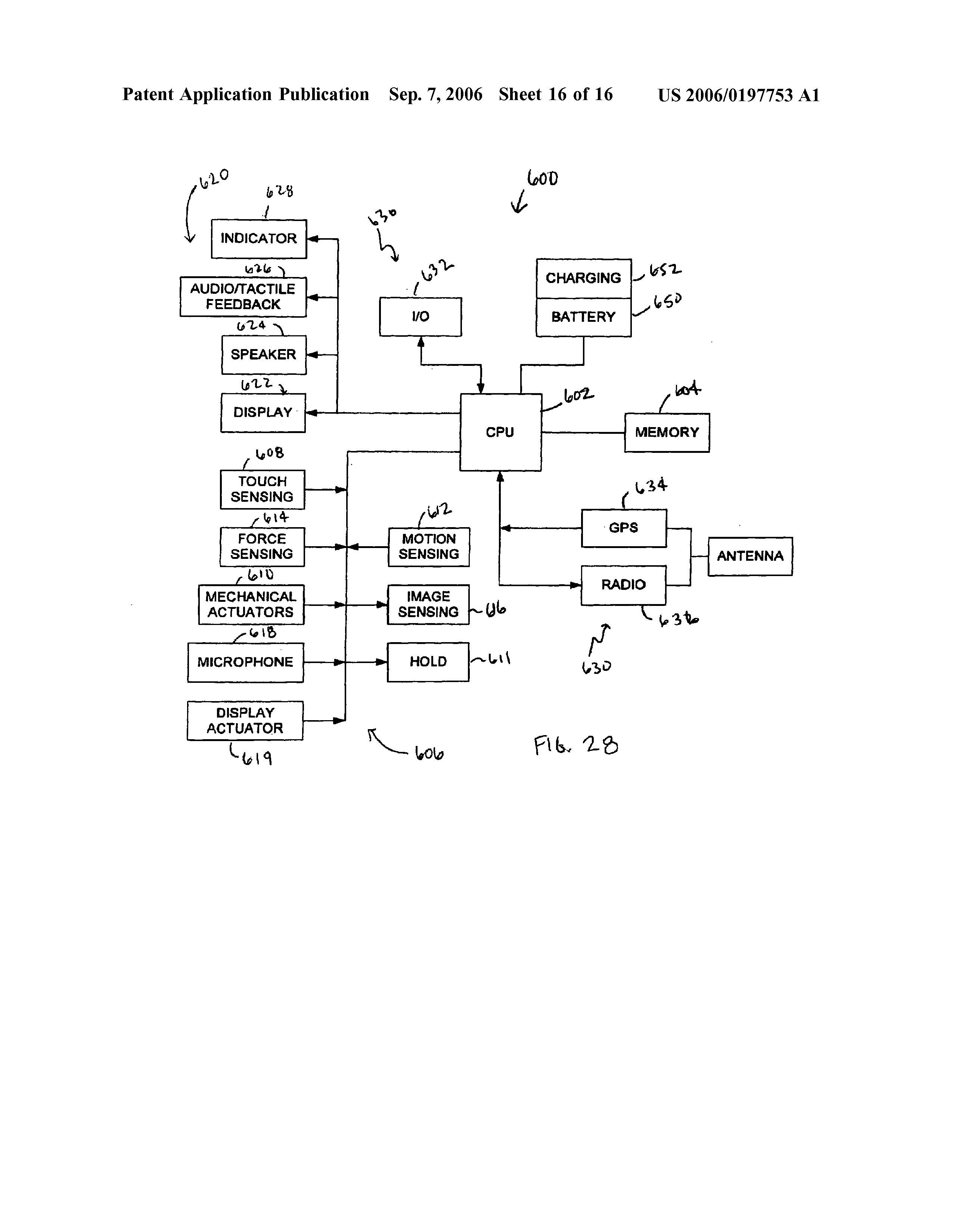 Suiter Swantz IP is a full-service intellectual property law firm, based in Omaha, NE, serving all of Nebraska, Iowa, and South Dakota. If you have any intellectual property questions or need assistance with any patent, trademark, or copyright matters and would like to speak with one of our patent attorneys please contact us.
Suiter Swantz IP is a full-service intellectual property law firm, based in Omaha, NE, serving all of Nebraska, Iowa, and South Dakota. If you have any intellectual property questions or need assistance with any patent, trademark, or copyright matters and would like to speak with one of our patent attorneys please contact us.
Amazon Patents Self-Destructing Drone
Amazon was recently in the news for one of their patent applications dealing with advances in drone technology. Amazon was granted a patent for its invention on “Directed Fragmentation for Unmanned Airborne Vehicles” (aka self-destructing drones), U.S. Patent No. 9,828,097. While the invention may sound destructive in nature, Amazon designed this unmanned airborne vehicle (UAV) to cause less damage by self-destructing into small pieces, which pose less risk to people and property than fully intact drones.
This self-destructing drone would work hand-in-hand with their other drone technologies, such as their delivery drone technology. If the purchaser selects drone delivery when placing the order, Amazon will assign a flight controller who will determine the flight path and control the operation. A fragmentation controller is also assigned and will be responsible for developing and updating fragmentation sequences. The fragmentation sequence includes a system that will release one or more of the drone’s components if the flight path is interrupted.
The technology is so advanced that the drone will be able to determine a suitable place to eject its components based on “terrain topology information or data [that] can identify certain preferred locations for dropping one or more of the components of the UAV.” The fragmentation controller can determine a desired time for a drone to destruct based on an interrupted flight plan, which “can result in the UAV, and certain parts of the UAV, landing at more preferable or suitable locations.”
This technology is clearly designed for safety but it has some wondering what will happen to the packages and the components after the drone has been destructed. Amazon answered this question with U.S. Patent No. 9,828,091, “Item Delivery with an Unmanned Aerial Vehicle and Unmanned Aerial Vehicle Retrieval System.” The technology details plans for a service to retrieve drones and their components in a one-way trip. It is further designed to “transport ordered items to the user specified delivery destination but not return to a materials handling facility under its own power. Instead, the one-way UAV may remain at the delivery destination for later retrieval by a retrieval unit (e.g., truck).” In other instances, the UAV will not be returned because it may be disposable, part of the delivery item, and/or it may be made of recyclable material.
Consumers should not expect to see self-destructing drones anytime soon. Amazon still needs to work through FCC compliance and other federal, state, and local government approval.
Suiter Swantz IP is a full-service intellectual property law firm, based in Omaha, NE, serving all of Nebraska, Iowa, and South Dakota. If you have any intellectual property questions or need assistance with any patent, trademark, or copyright matters and would like to speak with one of our patent attorneys please contact us.
“O Christmas tree, O Christmas tree” a Look at Your Intellectual Property
Christmas trees are an essential element of Christmas and the holiday season. According to the American Christmas Tree Association’s (ACTA) seventh annual Christmas tree survey, nearly 95 million households across the U.S. will display a Christmas tree this year. Of those Christmas trees displayed, 81 percent will be artificial and 19 percent will be real[1]. And, like any other innovation, Christmas trees have an interesting intellectual property history.
German immigrants brought the tradition of the Christmas tree with them to the United States in the 1700s. German settlers would commonly display community trees in town squares or other public spaces. At that time, many Americans did not accept the notion of a Christmas tree as they associated the trees with paganism. The first recorded instance of an in-home Christmas tree in the United States did not occur until the 1830s.
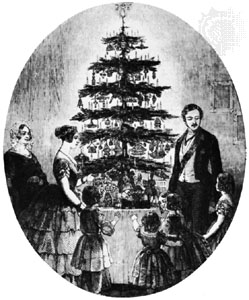
In 1846, the London News depicted Queen Victoria and Prince Albert with their children gathered around a Christmas tree. Queen Victoria was very popular among the people and almost everything she did became fashionable. Shortly thereafter, Christmas trees began popping up all over Britain. Americans along the East Coast, no stranger to trend setting and fashion, took note of the trend and soon began displaying Christmas trees in their homes.
After the adoption of the Christmas tree as an annual tradition, people soon began inventing ways to decorate the trees. Prior to the invention of the light bulb, people brightened the trees by adding wax candles to recreate the wintertime sight of twinkling stars. Not surprisingly, a tree decked with burning candles created an extreme fire hazard and, as a result, many people lost their homes. Charles Kirchhof tried to alleviate the fire hazard with his invention of the “Candle Holder” (U.S. Patent No. 72,506) which was constructed for conveniently attaching candles, ornaments, or other objects to and maintaining above any oscillating support (as the branches of a tree) in their proper position. This invention was a step in the right direction but an open flame around a tree was still a major concern.
Thankfully, Thomas Edison improved his lightbulb invention and was unsurprisingly involved in the creation of the first Christmas lights (Patent No. 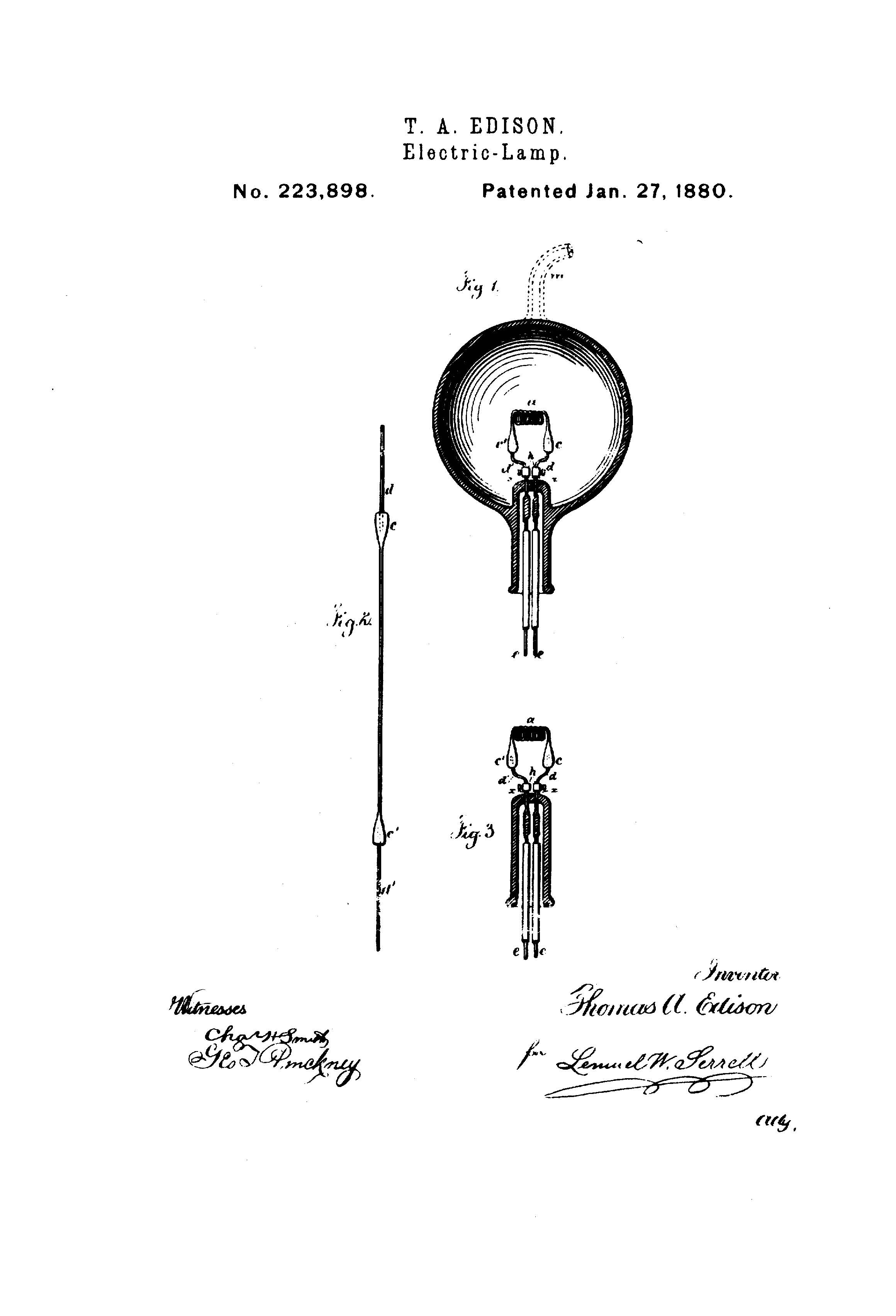 223,898). Edison’s partner and VP of Edison Electric Light Company, Edward Hibberd Johnson, has been called the “father of electric Christmas lights.”. He took Edison’s carbon filament light bulbs, wired them on a strand, and adorned the tree in his house, covering it with 80 red, white, and blue bulbs. The concept quickly spread across the country. President Grover Cleveland requested that over a hundred bulbs be strung on the Christmas tree in the White House.
223,898). Edison’s partner and VP of Edison Electric Light Company, Edward Hibberd Johnson, has been called the “father of electric Christmas lights.”. He took Edison’s carbon filament light bulbs, wired them on a strand, and adorned the tree in his house, covering it with 80 red, white, and blue bulbs. The concept quickly spread across the country. President Grover Cleveland requested that over a hundred bulbs be strung on the Christmas tree in the White House.
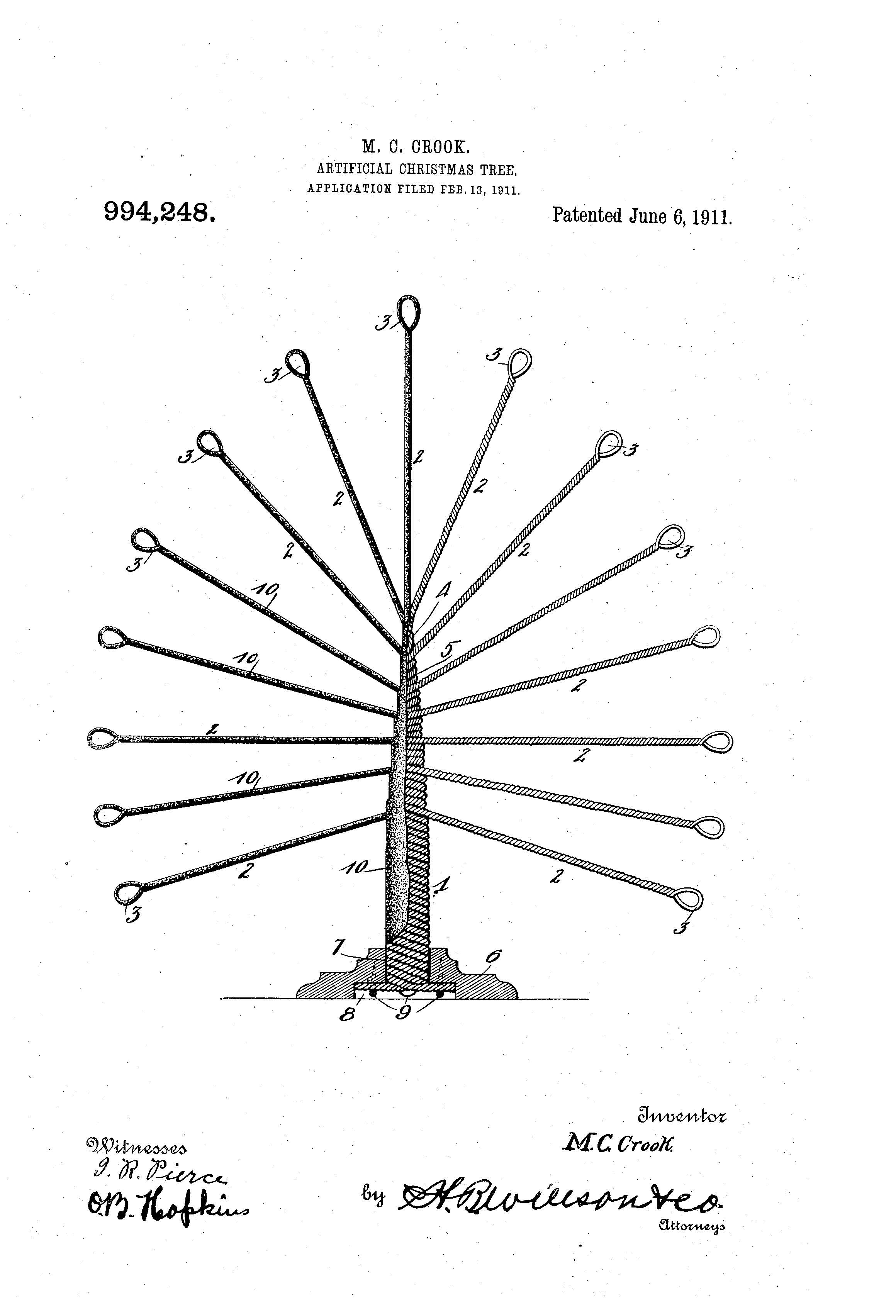 For the longest time, real trees were the only option available to those who wanted the display in their home. One of the first known artificial Christmas trees was invented by Nebraska native Mary Crook in 1911, U.S. Patent No. 994,248. This artificial tree was designed to provide an illusion of a real Christmas tree by having the trunk and branches formed of covered twisted wires to simulate that of natural tree branches. Another aspect was to ensure that the tree was strong, durable, fireproof, and inexpensive.
For the longest time, real trees were the only option available to those who wanted the display in their home. One of the first known artificial Christmas trees was invented by Nebraska native Mary Crook in 1911, U.S. Patent No. 994,248. This artificial tree was designed to provide an illusion of a real Christmas tree by having the trunk and branches formed of covered twisted wires to simulate that of natural tree branches. Another aspect was to ensure that the tree was strong, durable, fireproof, and inexpensive.
New artificial trees are designed for easy assembly; for example, “Artificial Christmas Tree” (U.S. Patent No. 5,855,705) is constructed for a quick assembly and comes with the lights preassembled. If that is too much work, there is the “Pop-Up Christmas Tree” (US 2009/0289560) that has an electrically motorized power antenna assembly. It can be removed from packaging and assembled with a remote control to form a realistic tree.
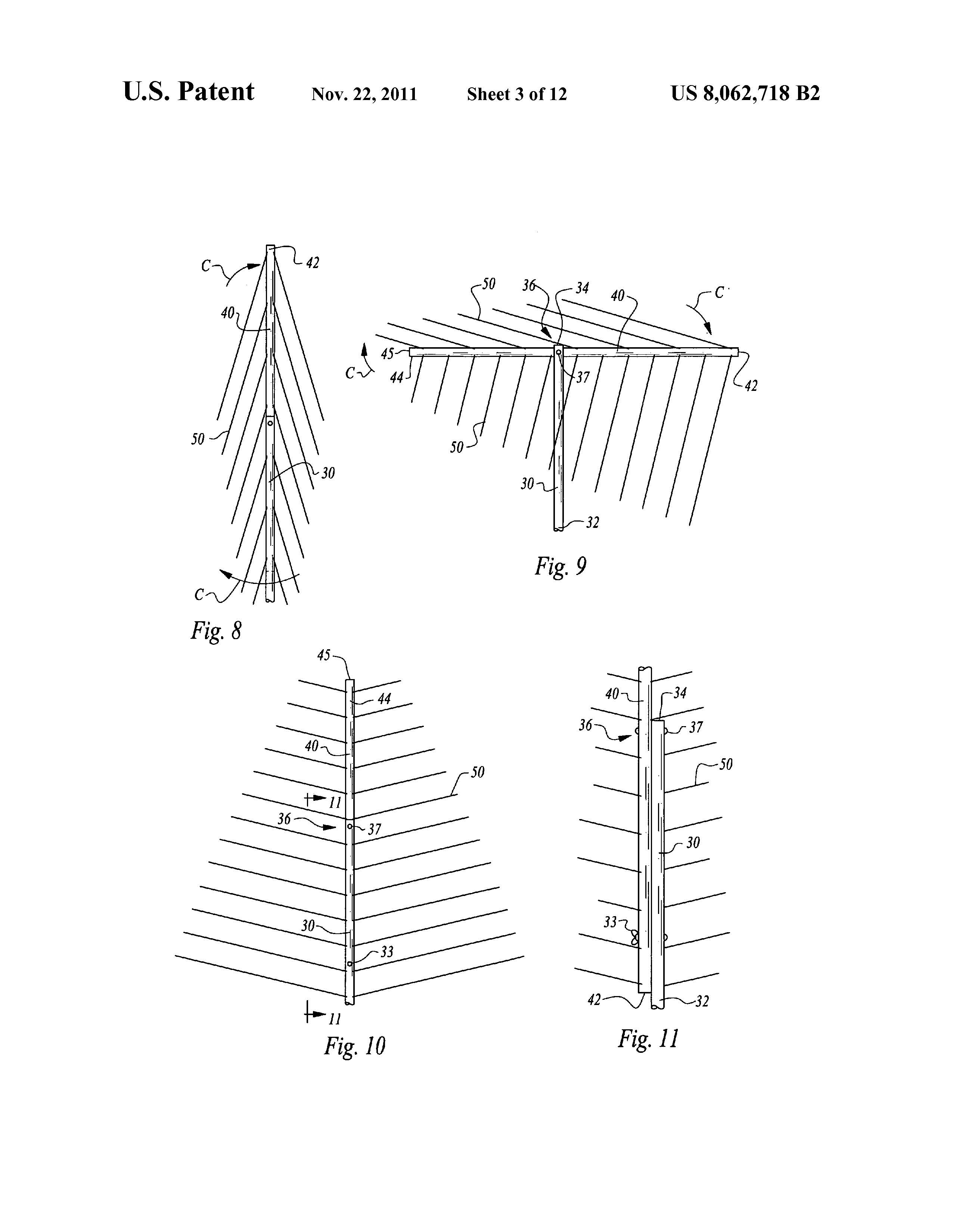 One company, Balsam Hill, sells artificial Christmas trees, which are excellent facsimiles of real trees. Their trees have been seen in the Macy’s Thanksgiving Day Parade, movie sets, and in the homes of celebrities. They not only manufacture artificial trees, they also possess patents on the trees such as, “Invertible Christmas Tree” (U.S. Patent No. 8,062,718) and “Collapsible Artificial Tree” (U.S. Patent No. 9,040,130). The invertible tree can be collapsed and stored when not in use. The branches collapse by rotation of one portion of the tree relative to the second portion for a quick and easy disassembly.
One company, Balsam Hill, sells artificial Christmas trees, which are excellent facsimiles of real trees. Their trees have been seen in the Macy’s Thanksgiving Day Parade, movie sets, and in the homes of celebrities. They not only manufacture artificial trees, they also possess patents on the trees such as, “Invertible Christmas Tree” (U.S. Patent No. 8,062,718) and “Collapsible Artificial Tree” (U.S. Patent No. 9,040,130). The invertible tree can be collapsed and stored when not in use. The branches collapse by rotation of one portion of the tree relative to the second portion for a quick and easy disassembly.
Whether you have a real tree, fake tree, or no tree at all, everyone at Suiter Swantz IP would like to wish you and yours a Merry Christmas and a Happy Holiday Season!
[1] American Christmas Tree Association https://www.christmastreeassociation.org/
2017 Diaper Drive Results
Thanks to everyone who donated this year. We were able to donate 3,318 diapers to the women and children of the Lydia House. Way to go!

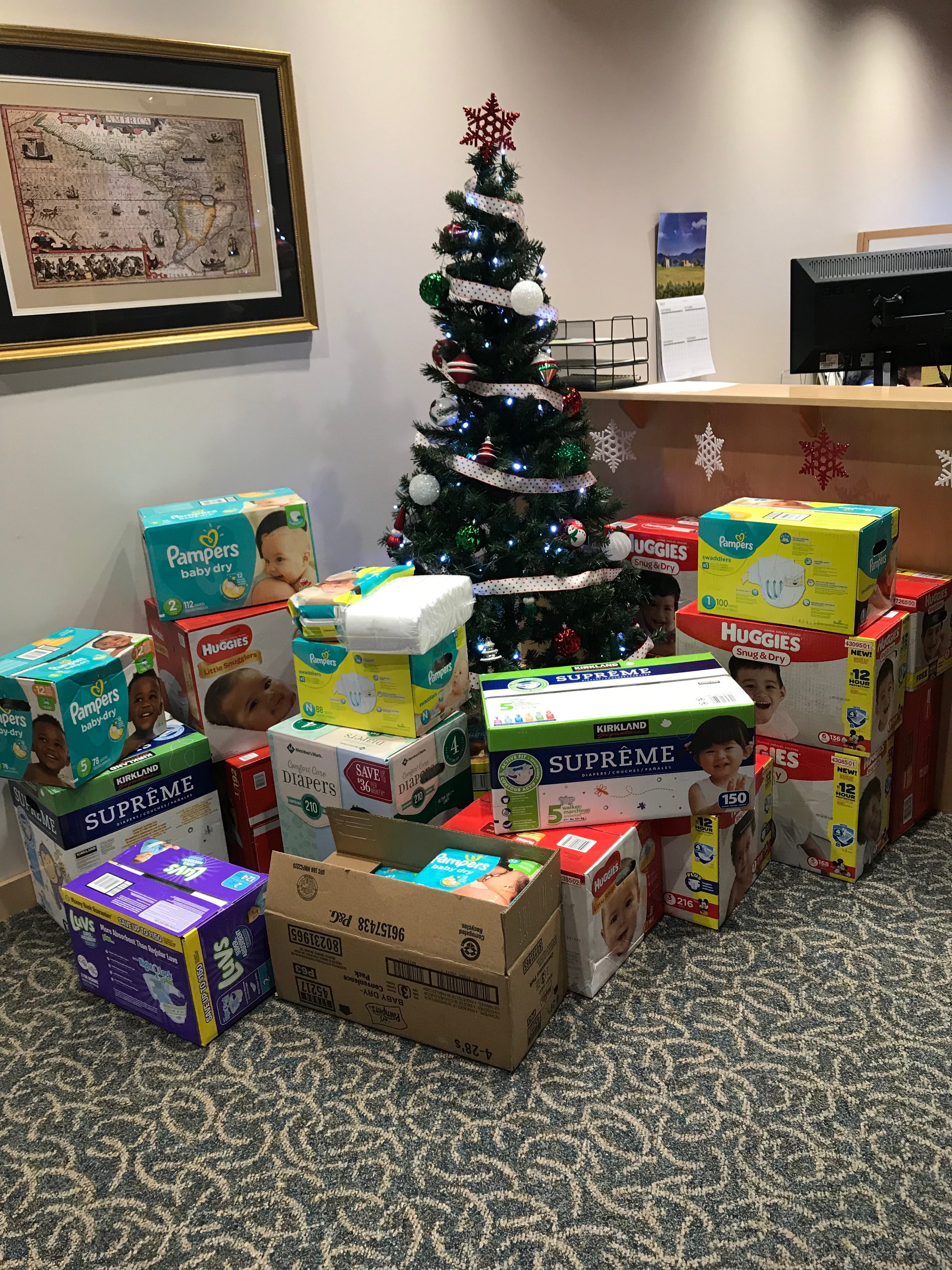
May the 4th be with Star Wars Intellectual Property
Since the first film of the Star Wars saga, released in 1977, George Lucas and Lucasfilm have become profoundly adept at dealing with legal matters concerning intellectual property. With 205 patents, 1,077 individual trademark applications, and 3,489 registered copyrights under the Lucasfilm empire, it is clear that Lucas and Lucasfilm have been nothing but persistent in protecting their intellectual property rights.
Disney, who acquired Lucasfilms in 2012, recently filed a patent application for a real-life lightsaber (sort of). The “Audience Interaction Projection System” (U.S. Patent Application Serial No. 14/596,153) will project a virtual lightsaber which will allow guests in Disney’s Star Wars Park to fight off the virtual lightsaber as if they were in combat. The “Audience Interaction Projection System” utilizes a drone to transmit laser light in order to produce the virtual lightsaber. A hazy fog matter will increase the visibility of a laser, which will allow theme park guests to use their own lightsabers to deflect the beams from the drone. As if that wasn’t enough, the virtual lightsaber will include haptic feedback and the characteristic lightsaber hum which will let the users know if they’ve been struck by the lightsaber, giving them a real life Jedi experience.
14/596,153) will project a virtual lightsaber which will allow guests in Disney’s Star Wars Park to fight off the virtual lightsaber as if they were in combat. The “Audience Interaction Projection System” utilizes a drone to transmit laser light in order to produce the virtual lightsaber. A hazy fog matter will increase the visibility of a laser, which will allow theme park guests to use their own lightsabers to deflect the beams from the drone. As if that wasn’t enough, the virtual lightsaber will include haptic feedback and the characteristic lightsaber hum which will let the users know if they’ve been struck by the lightsaber, giving them a real life Jedi experience.
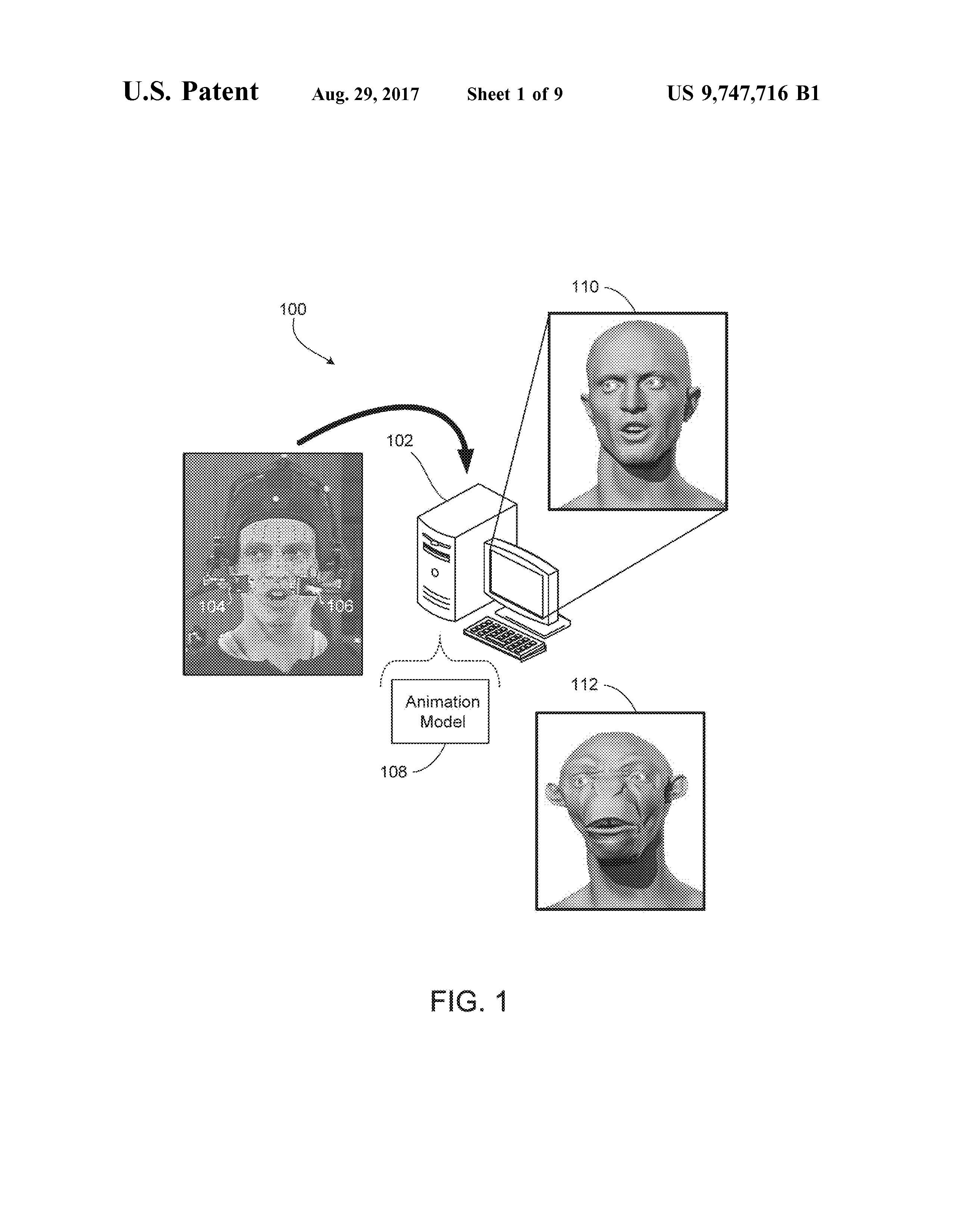 On a broader scale, Lucasfilms has also taken the forefront on many advanced cinematic technologies used to create more lifelike experiences for moviegoers. For example, the Lucasfilm patent entitled “Creating Character for Animation” (U.S. Patent No. 8,477,140) is a computer-implemented method which allows graphic designers to create more fluid, realistic, and life-like character mutations on-screen. As another example, the Lucasfilm patent entitled “Facial Animation Models” (U.S. Patent No. 9,747,716) claims a system which may allow graphic designers to create ultra-lifelike fictional characters, and even allow them to model the fictional characters to mimic real life actors.
On a broader scale, Lucasfilms has also taken the forefront on many advanced cinematic technologies used to create more lifelike experiences for moviegoers. For example, the Lucasfilm patent entitled “Creating Character for Animation” (U.S. Patent No. 8,477,140) is a computer-implemented method which allows graphic designers to create more fluid, realistic, and life-like character mutations on-screen. As another example, the Lucasfilm patent entitled “Facial Animation Models” (U.S. Patent No. 9,747,716) claims a system which may allow graphic designers to create ultra-lifelike fictional characters, and even allow them to model the fictional characters to mimic real life actors.
As noted above, Lucasfilms owns over 1,000 individual trademarks. Furthermore, many of Lucasfilm’s trademarked phrases and words include registrations in multiple international classes, claiming protection in a wide variety goods and services. Unsurprisingly, Lucasfilm has trademarked the  term “Star Wars” (U.S. Registration No. 1127229), which was issued December 4, 1979. Additionally, many Star Wars characters have been trademarked, including R2-D2, Darth Vader, Luke Skywalker, Princess Leia Organa, Ben (Obi-Wan) Kenobi, and Chewbacca. Lucasfilm uses the “Star Wars” and related Star Wars trademarks on a variety of goods, such as clothing, costumes, toys, and entire theme parks. To take its IP protection even further, Lucasfilm has even trademarked fun Star Wars-related phrases, such as “May the 4th be With You.” Additionally, a trademark application for Han Solo’s famous line “I got a bad feeling about this” is currently pending with the United States Patent and Trademark Office (USPTO).
term “Star Wars” (U.S. Registration No. 1127229), which was issued December 4, 1979. Additionally, many Star Wars characters have been trademarked, including R2-D2, Darth Vader, Luke Skywalker, Princess Leia Organa, Ben (Obi-Wan) Kenobi, and Chewbacca. Lucasfilm uses the “Star Wars” and related Star Wars trademarks on a variety of goods, such as clothing, costumes, toys, and entire theme parks. To take its IP protection even further, Lucasfilm has even trademarked fun Star Wars-related phrases, such as “May the 4th be With You.” Additionally, a trademark application for Han Solo’s famous line “I got a bad feeling about this” is currently pending with the United States Patent and Trademark Office (USPTO).
George Lucas and Lucasfilm have even received trademark protection for the popular word “Droid,” a term coined by Lucas in the 1977 film Star Wars Episdoe IV: A New Hope when referencing R2-D2, C-3PO, and other automatons. Due to the fact that the term “droid” is protected by trademark, companies that wish to use the term in shows or films now have to pay Lucasfilm to use the word, or prepare to have possible legal action taken against them.
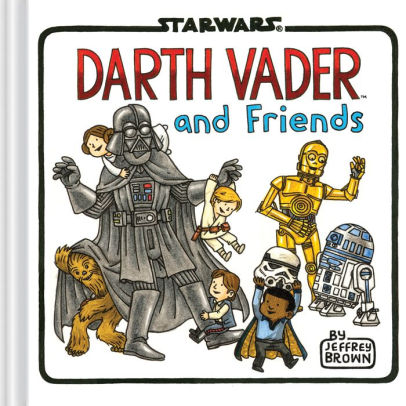 Lucasfilms has registered over 3,489 copyrights since 1978. The copyrights, a range of artistic expressions including scripts, sound recordings, and movie posters. Other copyrighted works include read-along story books with CDs, such as “Star Wars: Attack of the Clones,” adventure books, and chapter books. The copyrighted chapter book titled “Darth Vader and Friends,” a humorous title which plays on Darth Vader’s infamous sullen attitude and lack of many friends, explores the many friendships that have developed within the Star Wars saga.
Lucasfilms has registered over 3,489 copyrights since 1978. The copyrights, a range of artistic expressions including scripts, sound recordings, and movie posters. Other copyrighted works include read-along story books with CDs, such as “Star Wars: Attack of the Clones,” adventure books, and chapter books. The copyrighted chapter book titled “Darth Vader and Friends,” a humorous title which plays on Darth Vader’s infamous sullen attitude and lack of many friends, explores the many friendships that have developed within the Star Wars saga.
Lucasfilm has even gone as far as to copyright movie taglines. For example, the tagline, “The next chapter in the Skywalker saga continues as Rey develops her newly discovered abilities with the guidance of Luke Skywalker, who is unsettled by the strength of her powers.” is from newest Star Wars film set to premier this Thursday, December 14th.
To show your support for the Star Wars saga, and to see Lucasfilm's intellectual property hard at work first hand, go see Star Wars: The Last Jedi, and "may the force be with you!"
Suiter Swantz IP is a full-service intellectual property law firm, based in Omaha, NE, serving all of Nebraska, Iowa, and South Dakota. If you have any intellectual property questions or need assistance with any patent, trademark, or copyright matters and would like to speak with one of our patent attorneys please contact us.
Bud Light Sends Town Crier to Deliver Cease-and-Desist Notice
Bud Light certainly has a sense of humor when it comes to cease-and-desist notices.
Modist Brewing, a craft brewing company located in Minneapolis, Minnesota, recently launched a new Mosaic Double IPA they named “Dilly Dilly,” which, for those living under a rock, is a phrase Bud Light recently started using in their latest marketing campaign. Rather than send a traditional cease-and-desist letter, Anheuser-Busch InBev sent a medieval town crier to the Modist Brewing Company. The town crier theatrically unrolled a scroll and, in Old English, proclaimed:
“Hear ye, hear ye. Dear friend of the crown, Modist Brewing Company, congratulations on the launch of your new brew: Dilly Dilly Mosaic Double IPA. Let it be known that we believe that any beer that is shared between friends is a fine beer indeed. And, we are duly flattered by your royal tribute. However, ‘Dilly Dilly’ is the motto of our realm. So, we humbly ask that you keep this to a limited addition one-time-only run. This is by order of the king. Disobedience shall be met with additional scrolls, then a formal warning, and finally, a private tour of the pit of misery. Please send a raven, letter, or electronic mail to let us know that you agree to this request.”
Modist had developed the new beer and settled on the name “Dilly Dilly,” but, when they checked the United States Patent and Trademark Office (USPTO) to see if the name had already been claimed, they found Anheuser-Busch InBev had trademarked the phrase.
Kale Anderson, from Modist, said, “we realized the slogan was trademarked by Bud Light, not as a beer but just as a slogan, and got a little scared there for a little bit, but then we said, ‘Screw it, let’s see what happens.’ And that’s what happens.”
Modist’s attorney, Jeff O’Brien, has seen numerous cease-and-desist letters, but none as comical and good natured as this one. “There’s so many brewery names and beer names out there, and we try to resolve it short of suing each other,” O’Brien said. “They did it in a funny way and protected their mark. I thought it was a really cool way of handling it.”
In keeping with their good nature, Anheuser-Busch InBev offered Modist employees two “throne” seats to the 2018 Super Bowl where they can imbibe “in a few Bud Lights” on Bud Light’s tab. When asked how they will choose who gets the tickets, Modist said “if we do accept the offer, we'll likely host a jousting tournament in the back to see who gets to go."
Modist sent the crier home with a growler of the beer they will now call “Coat Tail” and proudly displayed the scroll on its menu board.
The nonsensical phrase “Dilly Dilly” has caught on and exceeded even the expectations of Anheuser-Busch InBev. Many are curious to the meaning of “Dilly Dilly.” When asked, Anheuser-Busch InBev Chief Marketing Officer, Miguel Patricio, said, “’Dilly Dilly’ doesn't mean anything. That's the beauty of it. I think that we all need our moments of nonsense and fun. And I think that ‘Dilly Dilly,’ in a way, represents that.”
Suiter Swantz IP is a full-service intellectual property law firm, based in Omaha, NE, serving all of Nebraska, Iowa, and South Dakota. If you have any intellectual property questions or need assistance with any patent, trademark, or copyright matters and would like to speak with one of our patent attorneys please contact us.
Patent of the Week: Mistletoe Supporting Headband
Mistletoe, a parasitic plant that thrives off the healthy plants it attaches itself to, is a plant that has been associated with Christmas for hundreds of years. The plant was used by many ancient cultures as a healing remedy used to cure ailments such as cramps, epilepsy, and ulcers.
The romantic nature of this plant was first seen with the Celtic Druids who believed the plant, which could thrive during the harsh winter months, could also help restore fertility among women and animals. It became a symbol of vivacity and fertility.
Norse mythology also played a part in the romance of mistletoe. Baldur, son of the goddess of love Frigg, was killed by mistletoe. When the other gods were able to revive him, Frigg declared mistletoe to be the symbol of love, promising to kiss all who pass beneath it.
In the Middle Ages and into the 18th century, mistletoe had become wildly popular as part of Christmas festivities. The tradition of kissing under the mistletoe is said to have started with servants in England. The men were allowed to steal a kiss from any woman standing underneath the mistletoe; to refuse the kiss was bad luck. In a different tradition, a person picks the berries from the mistletoe for each a kiss he or she received, once all the berries are gone, so are the kisses.
The MISTLETOE SUPPORTING HEADBAND, U.S. Patent No. 4,488,316, retains the tradition of kissing but adds a little twist to it. According to the application, the headband “will be worn on the head of the users, to display a piece of mistletoe above the forehead of its users, so as to entice a person or persons to kiss the wearer, as is an old Christmas custom.” The design of the headband allows the wearer to use real or fake mistletoe and seek out a person to kiss as opposed to traditional mistletoe which is typically placed in entryways and doorways.
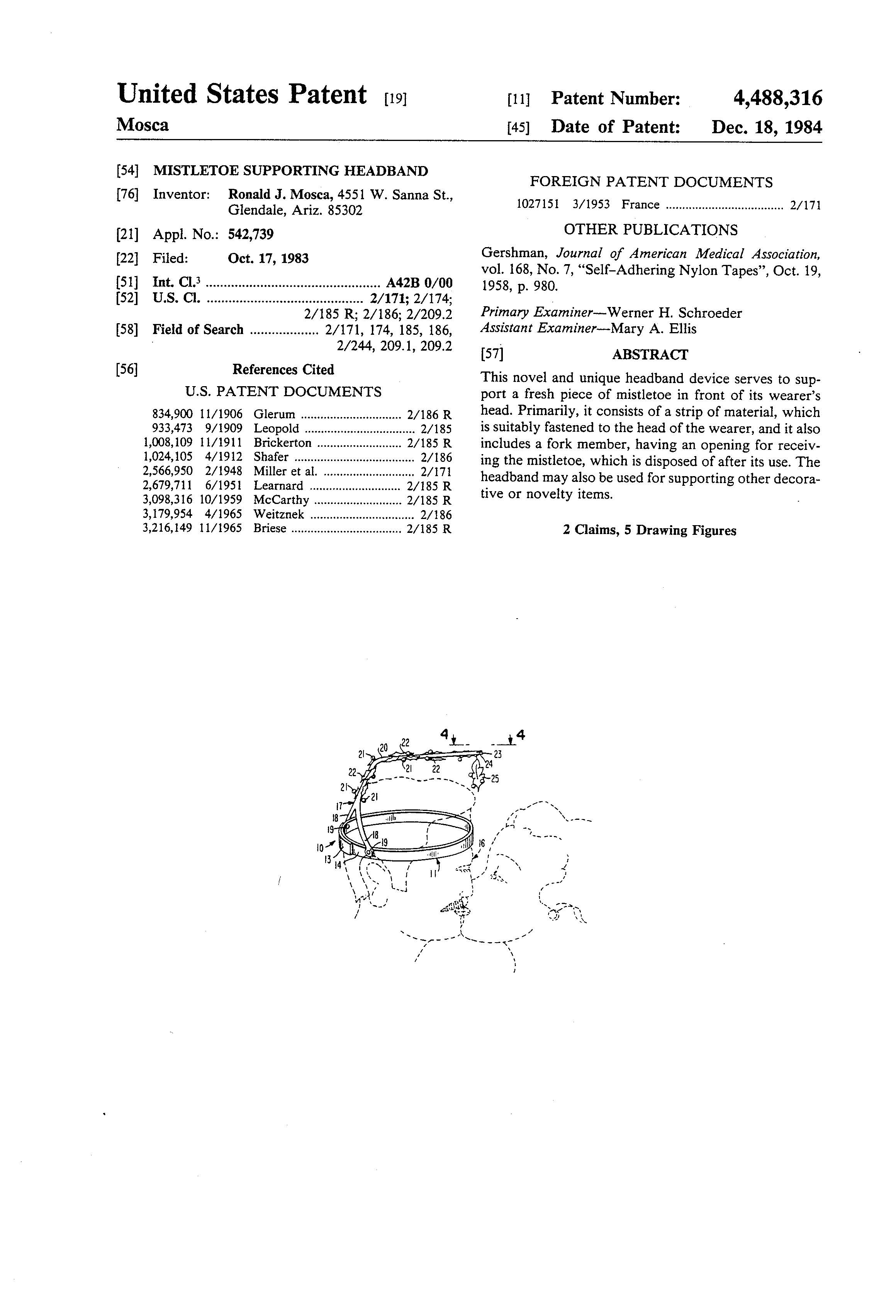
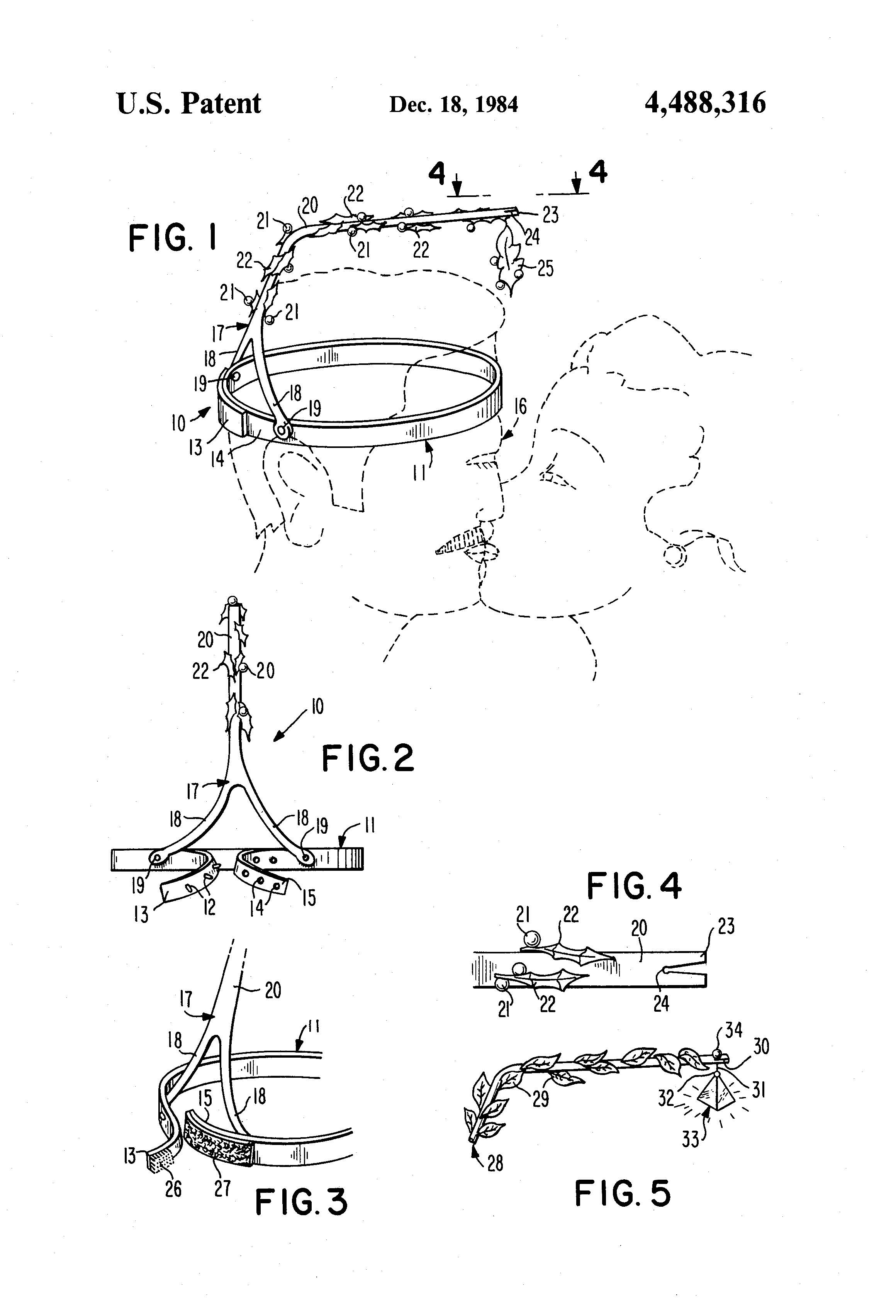
Suiter Swantz IP is a full-service intellectual property law firm, based in Omaha, NE, serving all of Nebraska, Iowa, and South Dakota. If you have any intellectual property questions or need assistance with any patent, trademark, or copyright matters and would like to speak with one of our patent attorneys please contact us.



